It’s too easy to forget the Renault Megane R.S. 300 when you think of a hot hatch. Others instantly spring to mind like the VW Golf R, Honda Civic Type R, and Hyundai i30N, with the Megane coming through later as an “oh, and I forgot the Megane RS.”
So then, you have to ask yourself: can the 2021 version of the Megane RS Trophy hold a candle to that mainstay that is the Golf R, let alone those cap-on-backwards whippersnappers like the Type R and i30N?
Now that we’ve made it to Level 2 of Lockdown, DriveLife spent a week with the 2021 Renault Megane R.S. Trophy 300.

WHAT’S IN THE 2021 RENAULT MEGANE RANGE?
Typing in 2021 Renault Megane R.S. Trophy 300 every time I want to mention this car is going to get boring, so from here on it’s known as the Megane, or R.S. You get the idea. The ‘300’ part of the name refers to the number of horsepower that this engine makes; an impressive number for an 1800cc motor.
Model choices? Manual or automatic, that’s your choice right there. Yep, there’s just one model of Megane R.S. Trophy is available in New Zealand, so that makes your choices lots easier. But does it? I would have sworn a manual over an automatic before driving the automatic Megane (our test car) but perhaps I’ve sold the automatic short.
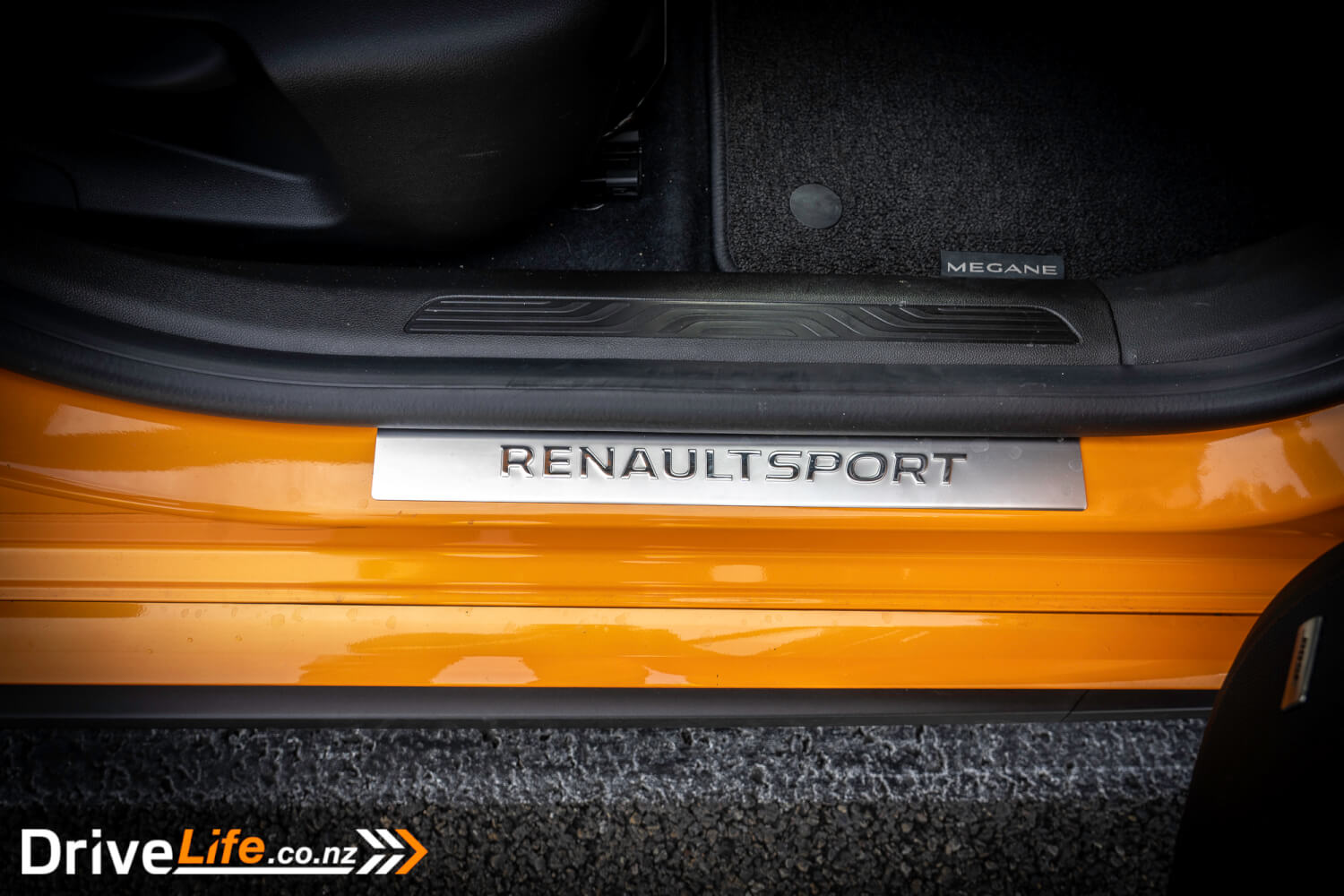
The manual has 20 less Nm of torque than the automatic, but otherwise all other specs are almost the same, namely:
- ‘4CONTROL’ (4-wheel steering)
- 19” Jerez R.S. alloy wheels
- An integrated 9.3” central touchscreen display
- Bose audio system
- Cup chassis with 4 hydraulic compression stops
- A Torsen limited-slip differential
- Red Brembo brake callipers
- Custom springs/shock absorbers
- Launch Control (automatic only)
- Front and rear parking sensors
- Rear-view camera
- Cruise control/speed limiter
- Hill start assist
- Tyre pressure monitoring system
- Android Auto and Apple CarPlay capability
- SatNav
- Electric folding and heated door mirrors
- Auto-down electric windows
- Dual-zone AC
- Keyless entry and start
- Automatic wipers
- Automatic headlights
- An R.S. Nappa perforated leather steering wheel and gear lever knob with R.S. airbag cover
- R.S. sports seats with integrated headrests
- Chrome-plated Renault Sport front door sills
- Alcantara R.S. black upholstery with red contrast stitching
- A 7” active driver’s display screen.

You don’t get launch control with the manual version, the automatic comes with alloy steering wheel paddles, Multi-Change Down (‘advanced downshift system’), and the automatic has an electric park brake (with Auto-Hold system) where the manual gearbox R.S. has a manual handbrake.
Power comes from a 1.8-litre inline four-cylinder petrol engine, which manages an outstanding 221kW of power and 420Nm of torque (400Nm in the manual version). The turbocharger has ceramic ball bearings to help it spin more freely.
The automatic gearbox is a 6-speed dual-clutch (DCT) unit, and the manual is also a 6-speed. Prices range from $65,990 for the manual to $68,990 for the automatic. Renault suggests fuel economy for the automatic to be 8.0L/100Km, and 8.3L/100Km for the manual.
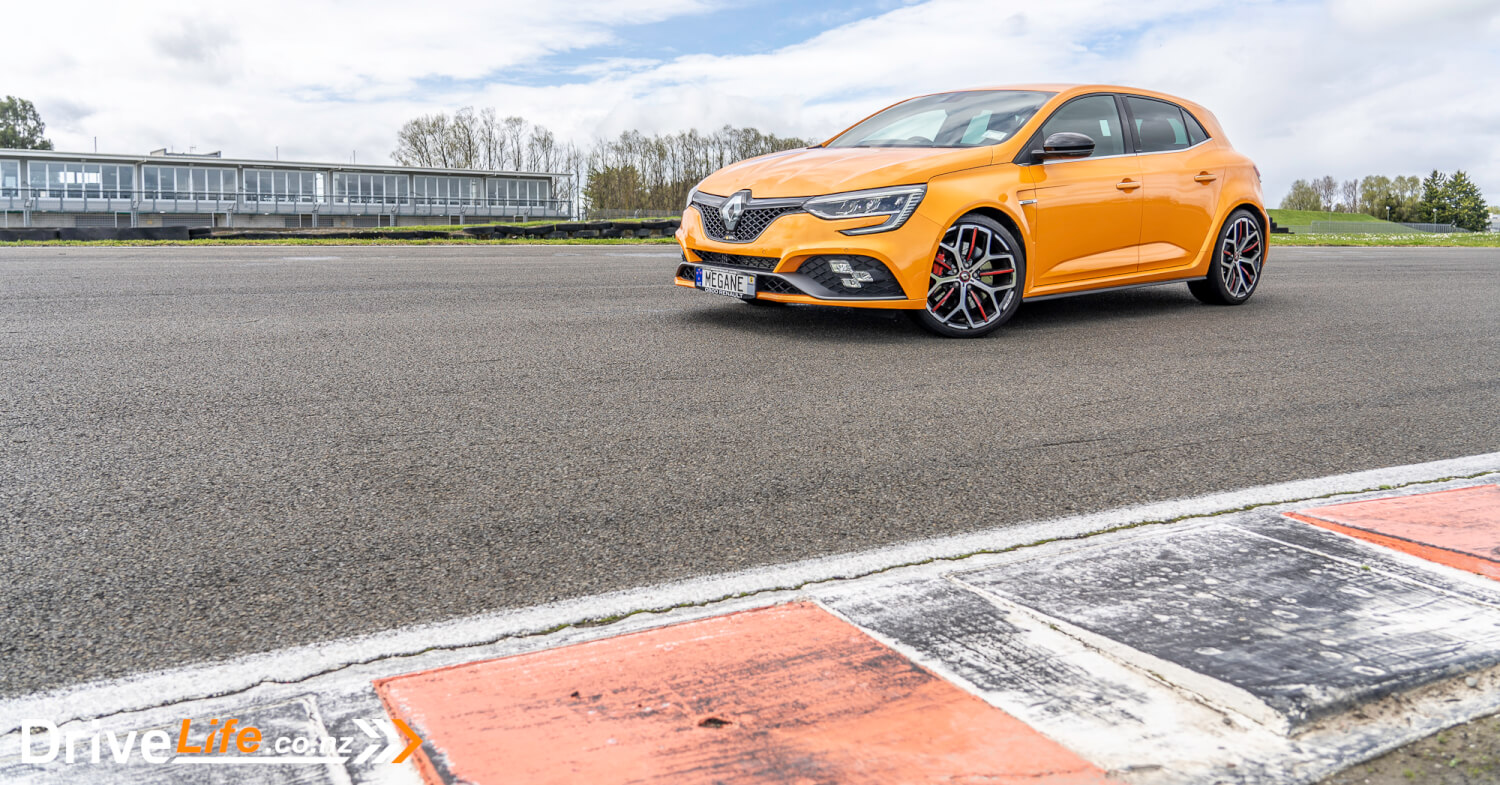
There’s an excellent range of colours for your Megane; Glacier White, Pearl White, Diamond Black, Starry Black, Flamme Red, Titanium Grey, Highland Grey, Sirius Yellow or Orange Tonic. The yellow and orange options do cost another $1,200 since they are Renault Sport colours.
You don’t get many options to pick from; a sunroof is $1990, Recaro seats another $2,990, and a change of wheel to 19” Fuji Light R.S. Trophy will set you back $990.
Check out the Renault New Zealand website for more Megane R.S. information.
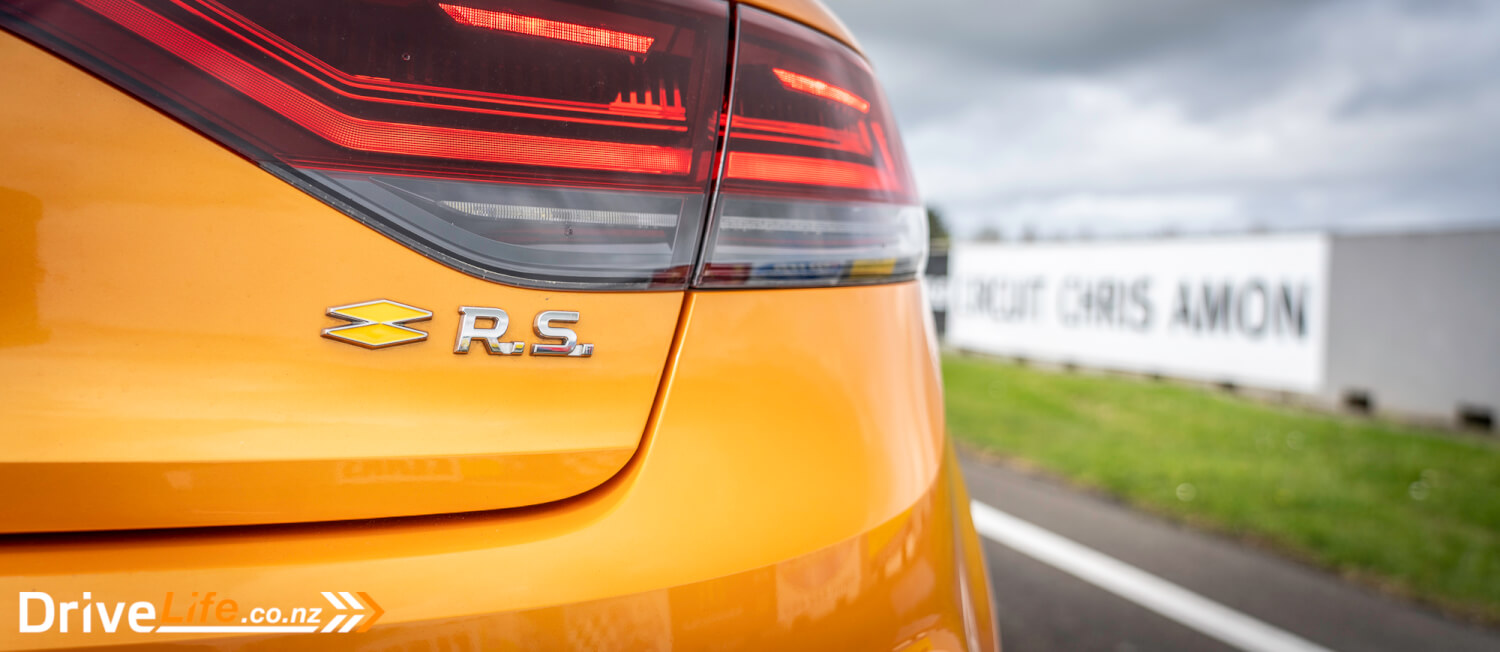
WHAT’S THE FIRST IMPRESSIONS OF THE 2021 RENAULT MEGANE R.S.?
All I could do was hope that Renault New Zealand would deliver a test car in either of the Renault Sport colours; Sirius Yellow, or even better still, Orange Tonic. For me, these are the only two colours for the Megane RS. As you can see, our test car is Orange Tonic, and it looks superb.
And in this colour? Awesome. It’s hard to see in the photos, but in the sunlight this car changes colours slightly with a bit of pearl coming through in the paint. So don’t fear if you think I’ve gone mad if the car simply looks orange to you – in the flesh, it’s a different colour.
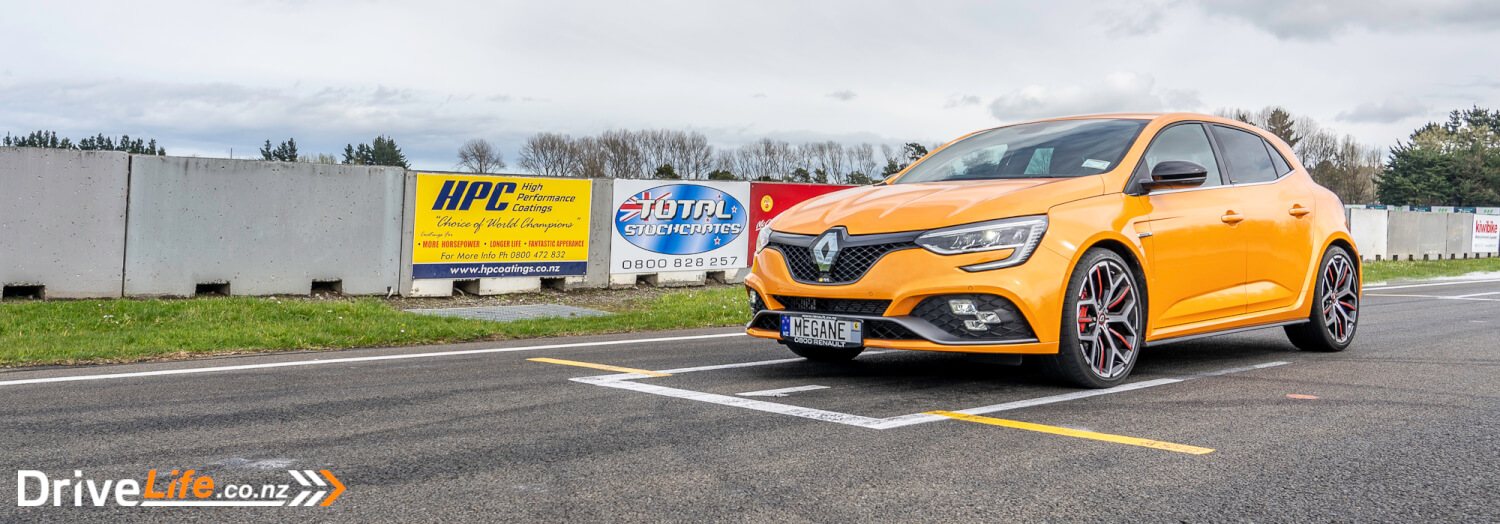
The 2021 version of this car has sharper lines all over, and it looks far better for it. Up the front, there’s an ‘F1 blade’, widened wheel arches, and lateral air extractor vents. With those R.S. LED 3-function lights (fog, cornering and long-range) it looks sharp as hell and certainly hits the sporty mark full-on. The rear of the car is just as good with a central exhaust, rear spoiler and diffuser. It looks the business from behind and that central exhaust is a treat.
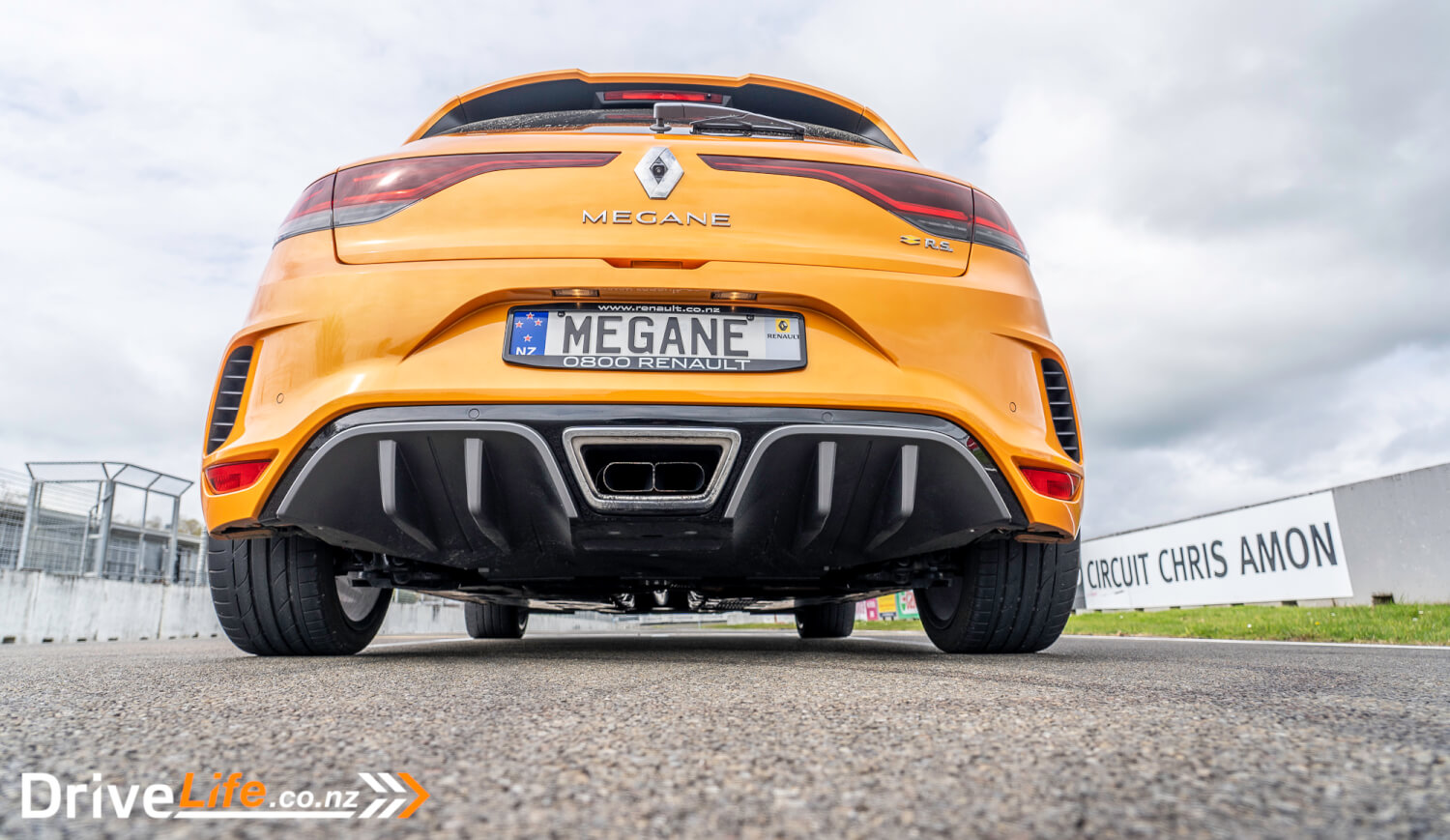
Then there are the rims. While our test car was fitted with the standard rims, and to me they looked amazing. The red-painted spokes, the design – everything about these wheels is totally awesome.
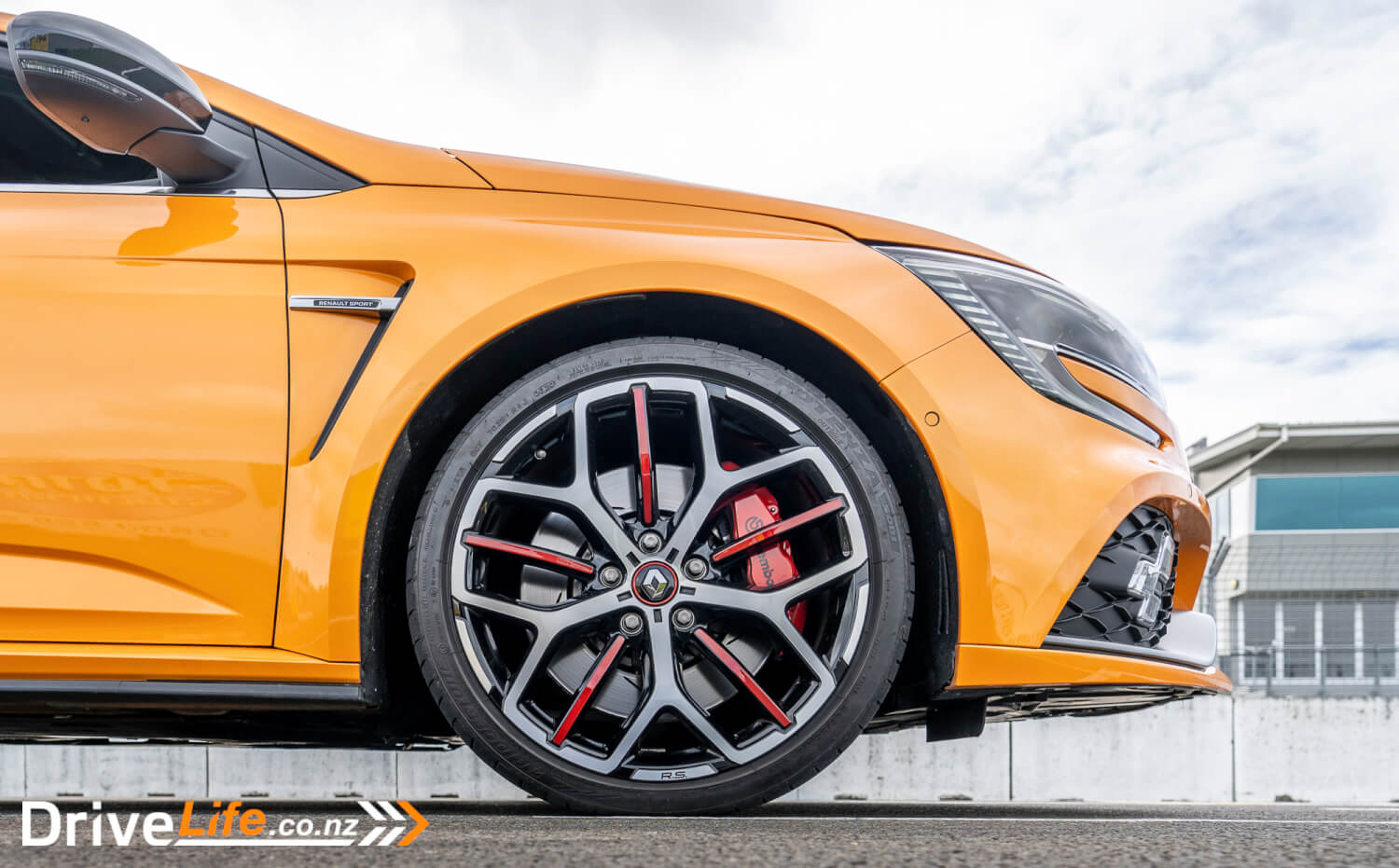
WHAT’S THE INTERIOR LIKE ON A 2021 RENAULT MEGANE R.S.?
A partly flat-bottom steering wheel greets you as you open the R.S.’s door, it’s perforated Nappa leather, chunky, small, and has a double-diamond R.S. badge on the lower spoke. Actually, as you open the door, firstly you’ll see the huge chrome-plated Renault Sport sill covers. Then the stainless-steel pedals catch your eye, along with a massive stainless-steel left-foot rest.
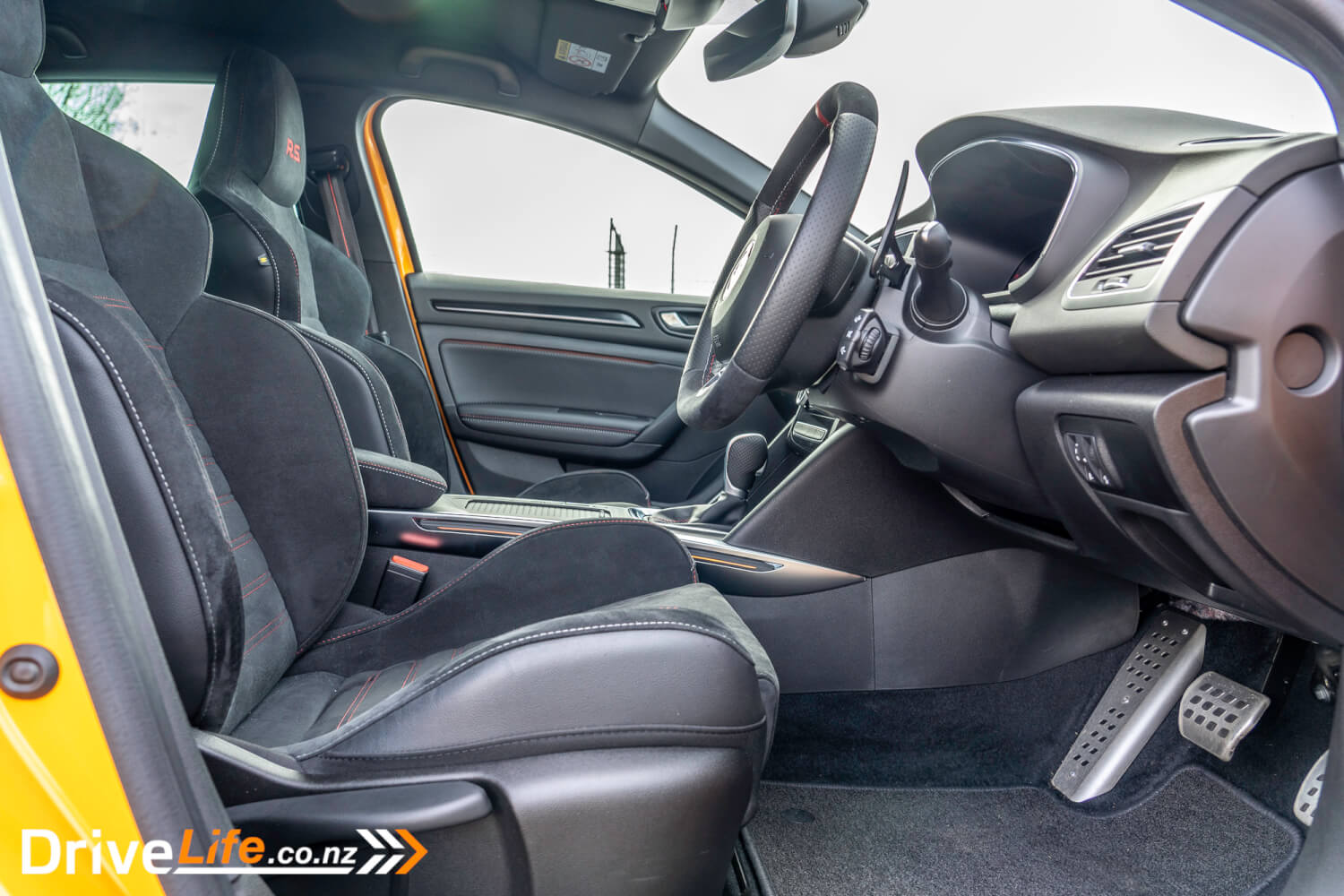
Adding to the sportiness is red stitching on the steering wheel, seats, gearshift gaiter, doors and console. All seatbelts have a red stripe running through the centre of them, just in case you weren’t sure this is a sports car.
Renault has added fake carbon fibre trim around the cabin, and this includes the doors, to the point of some padded pieces on the doors that are made to look like carbon fibre too. All the trim looks well made, well finished and fits well, with no misalignment or ugly gaps.
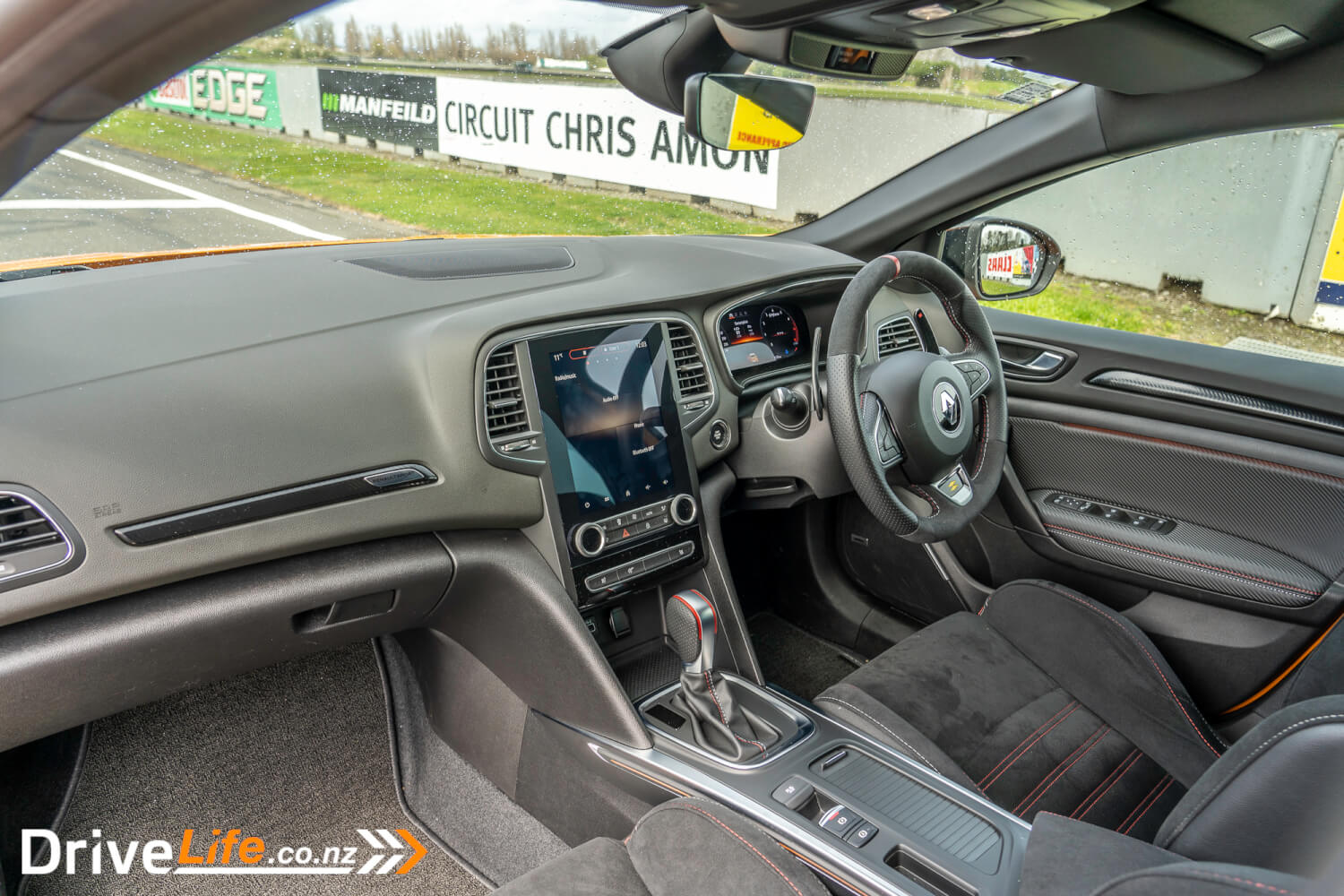
If that’s not enough to say Renault Sport, look at the seats. Fixed-headrest sports seats with massive bolsters, along with a bright red RS logo at the top. There’s no power adjustment for the seats; you can adjust the height manually, but the only extra for the seats is that they are heated. The seats are finished in Alcantara, which is perfect for holding you in place. That Alcantara is also on top of the centre console lid.
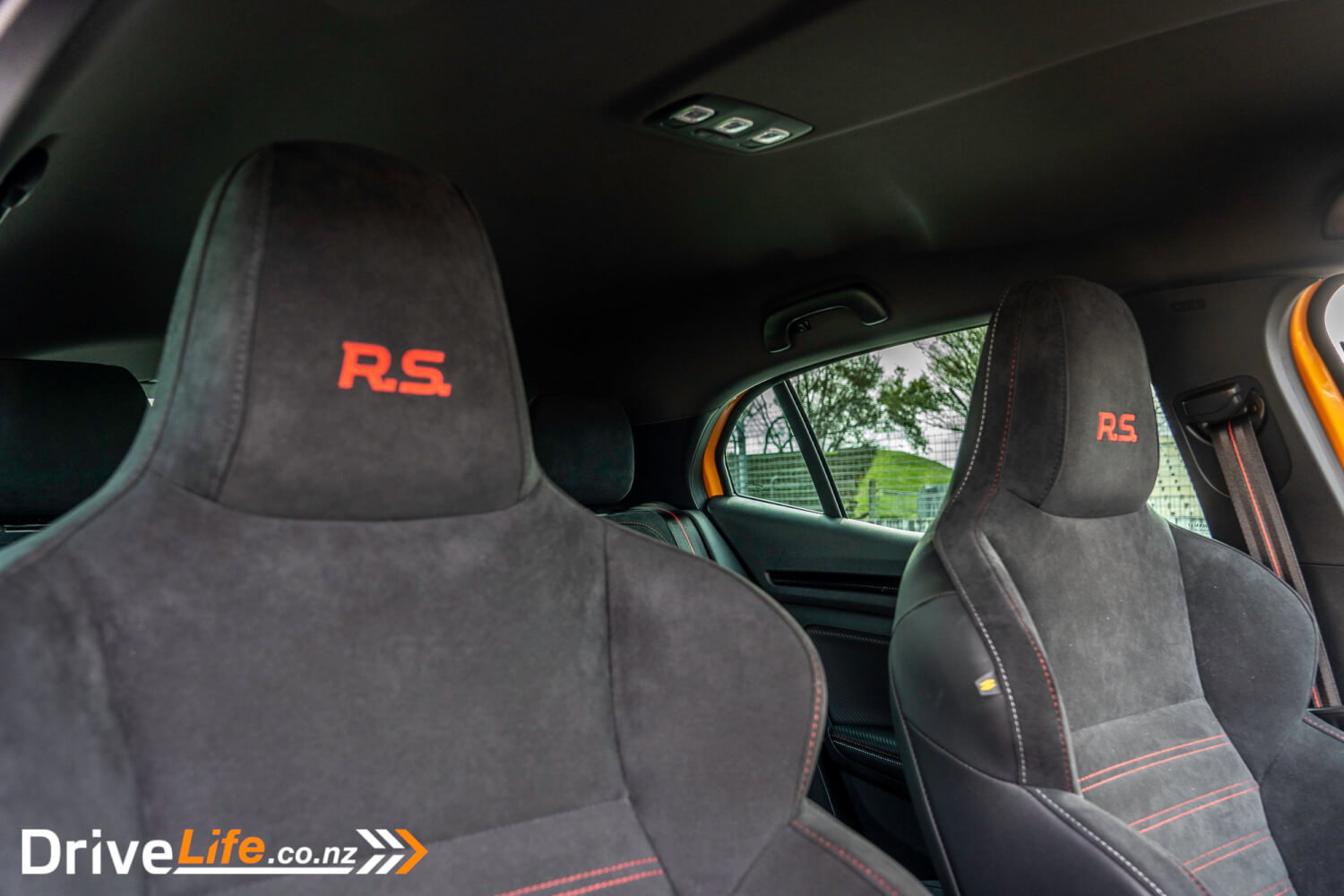
Everything is black inside the R.S. so those dabs of red are really needed. It’s a pretty dark cabin, and without the optional sunroof can feel a little claustrophobic.
In the front, amenities include an Aux port, along with two USB ports and a 12-volt socket. No Qi wireless phone charging here, this car is all about performance and handling. For that reason, it was a little strange to see an electric park brake – you need to buy the manual R.S. if you want a manual park brake. In saying that, at least the auto-hold function of the electric park brake stayed on all the time (when you exit the car then return), which is a bonus over so many other new cars.
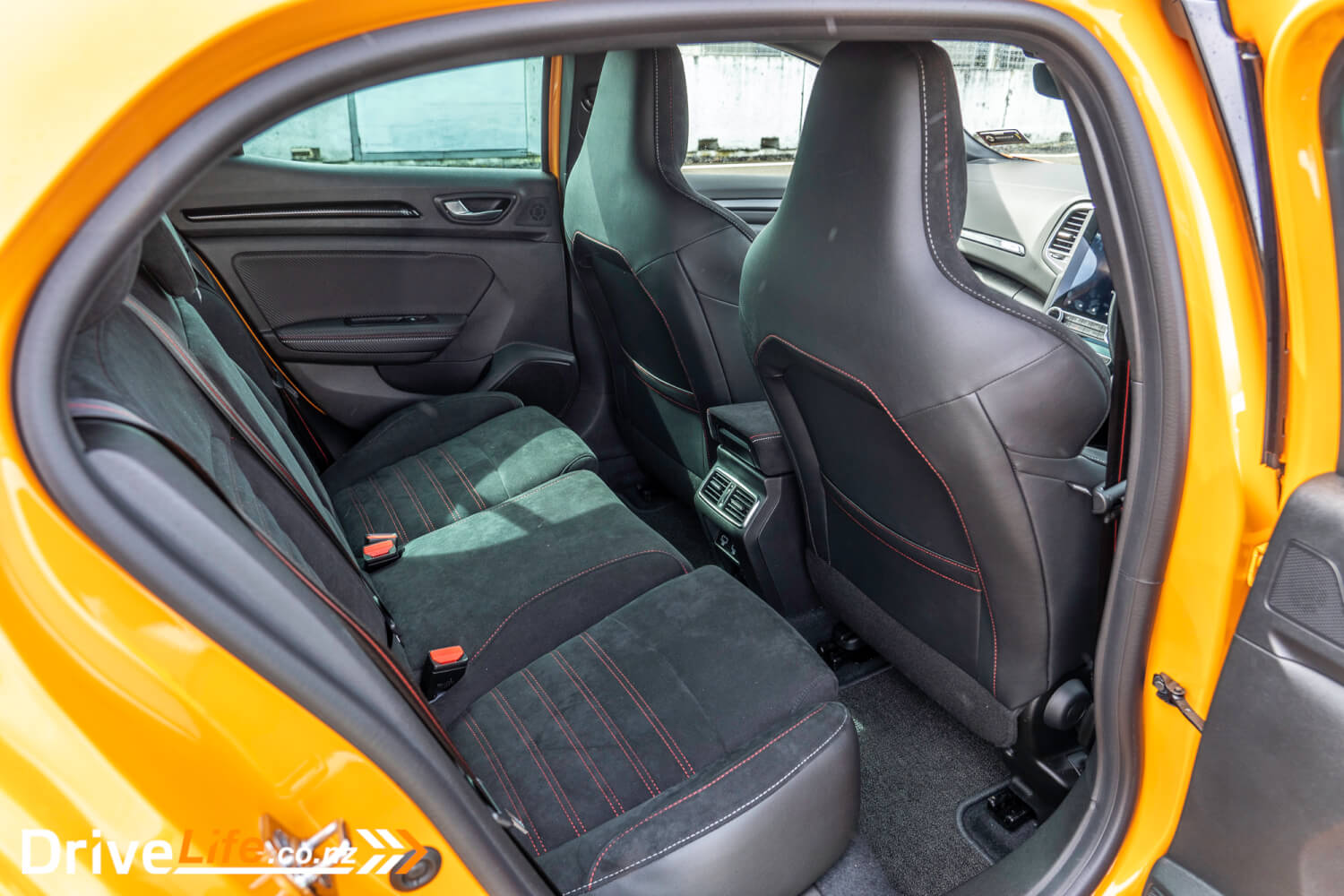
Rear legroom is very average, and headroom is not too generous. Still, rear-seat passengers also get access to two USB ports, as well as two air vents.
The boot is enormous at 434 litres – that’s over double the size of a Corolla hatch. There’s no spare under the floor, instead you get a 12-volt pump, which is placed next to the Bose Acoustic Wave System.
WHAT’S THE 2021 RENAULT MEGANE R.S. LIKE TO DRIVE?
I have a car-crazy friend who kept asking me if we were ever going to review the Megane R.S. Every month or so, it was “got a Megane R.S. coming yet?” Then, once he knew I was going to review the R.S., he was forever asking when it was arriving. I wasn’t sure why this was, when he’d been for trips in the Type R and i30N, not to mention some other pretty nice rides. But he always came back to asking when the R.S. was going to be reviewed.
After a few kilometres in the car, I could see why. It doesn’t take very far in this car for you to realise this ain’t no namby-pamby, wannabe race car. The steering is heavy, the ride is jiggly and it makes all sorts of noises in any gear in any drive mode. In a short distance, you get the feeling that this is a race car for the road, and not a road car you might take to the track, and a lot rawer than something like the Type R or i30N.
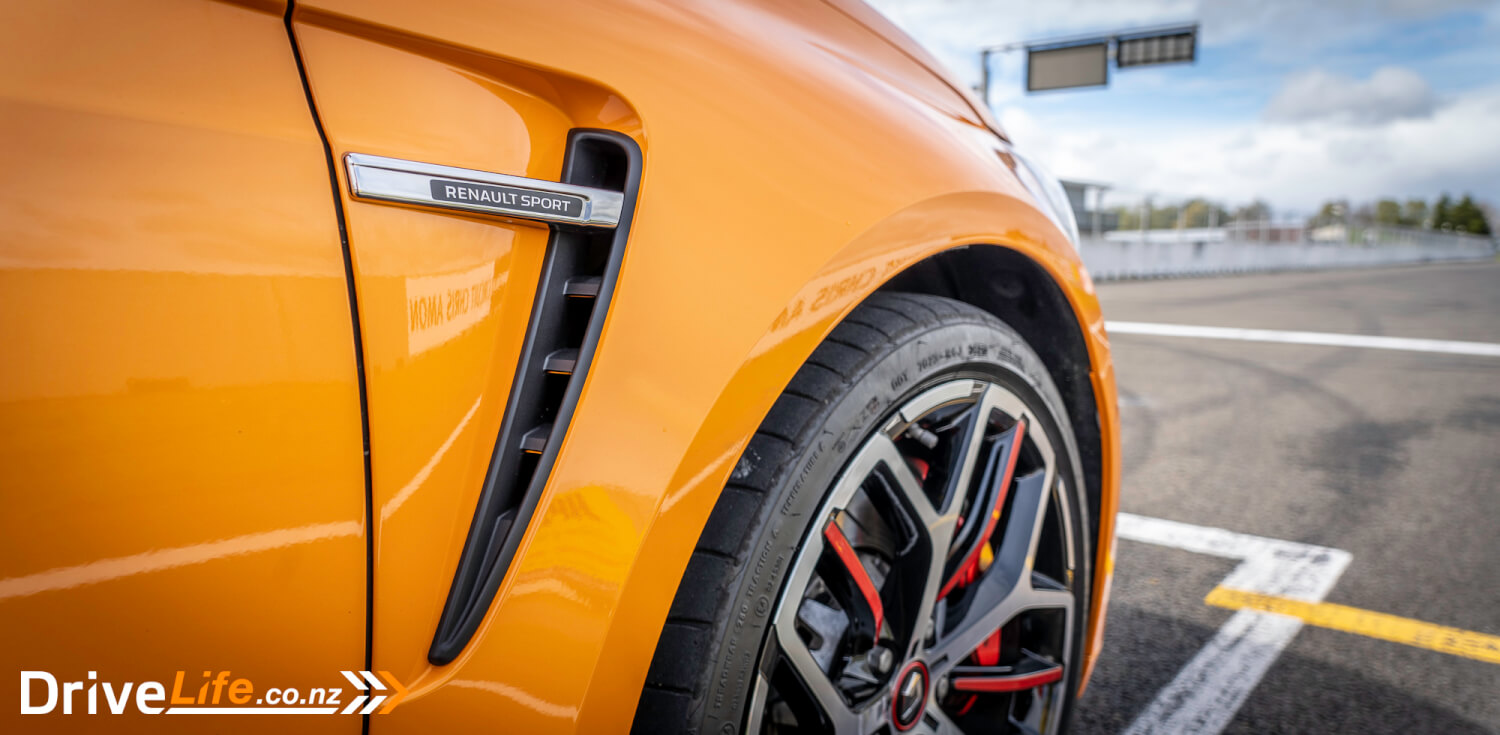
Starting the car, it reverts to ‘My Sense’ mode every time. My Sense is a programmable drive mode, but you can also tweak the other drive modes, just not to the same extent. So, if you have the exhaust set to Race in My Sense, you are going to get burbles and bangs on start-up. Is that what I did? Totally. Did the neighbours complain? Very much. The other drive modes are Sport, Race, and Save (Eco mode to you and me).
There’s a good list of things you can tweak in the settings for Drive modes, with each mode having a limited set that you can actually change. Settings you can edit include powertrain, 4 Control, engine sound, exhaust sound, lighting, AC, and throttle response. An example of editing the settings is Save mode; you can only adjust AC and lighting in this mode. I actually had to refer to the manual to check out some of the settings for Drive modes, and I found the instructions weren’t in the actual car’s manual, I had to look in the Multimedia manual to find out. Weird.
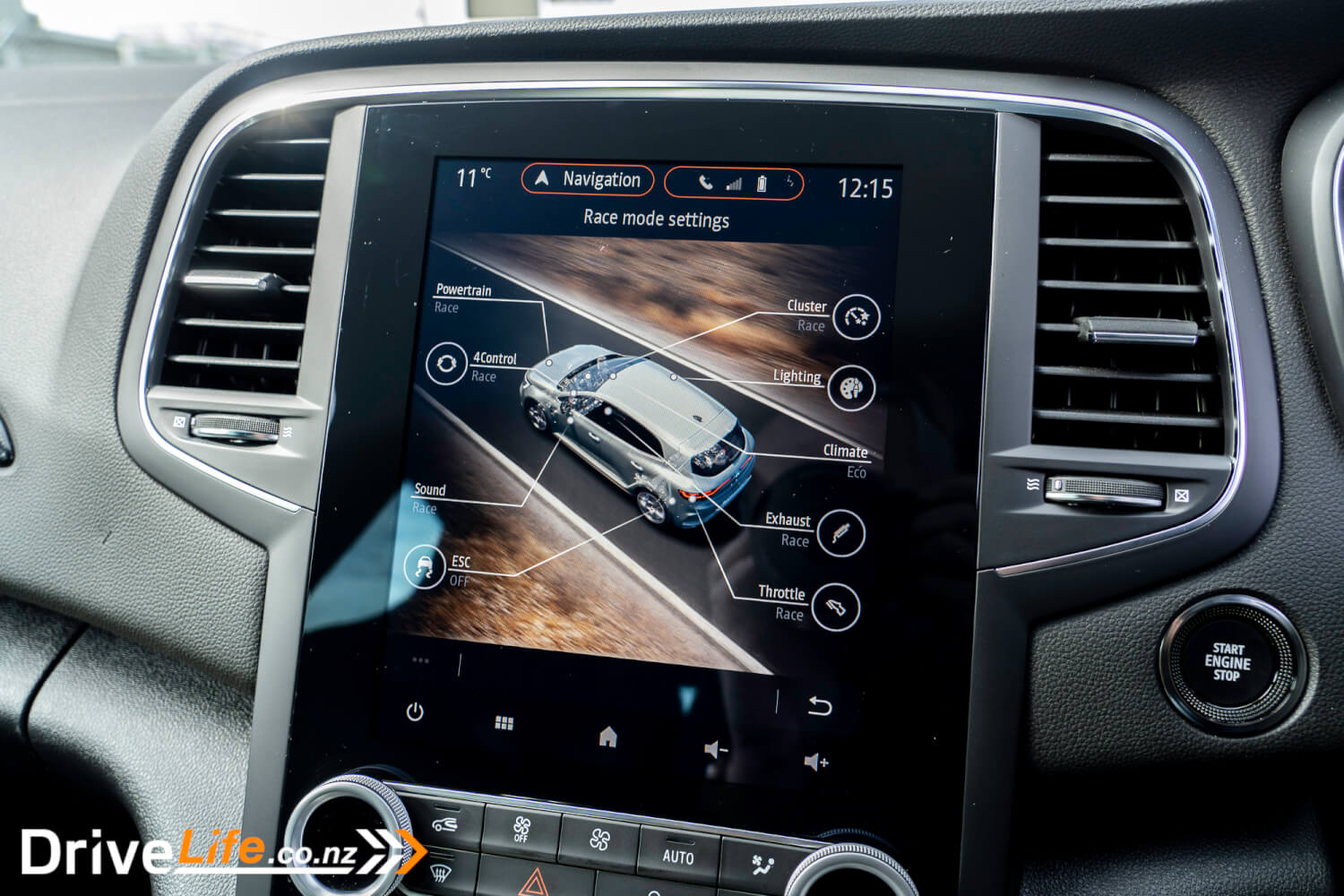
I see in overseas markets you can option adjustable dampers, but in New Zealand no such option. That means that the firm ride stays firm, no matter what drive mode you are in.
Selecting your drive mode was a little different to other cars; pressing the button on the centre console made the car move instantly to the next mode, when perhaps you just wanted to know what mode you were in. Not the end of the world, and I did play a lot with the modes in this car. While you can simply press that button to change the mode, you have to manually select Race mode on the central screen. The reason for this is that it disables traction control, and with 300 horsepower through the front wheels, you need it. I did test the car a few times in Race mode, and man, it’s a handful. Massive torque steer, lots of wheelspin, and lots of fun. While this may sound a bit scary, for me the overall experience of the R.S. was that it took me back to the 80s with front-wheel-drive cars with turbochargers and not much else. Those cars forced you to actually drive them, otherwise, they would bite you in the ass.
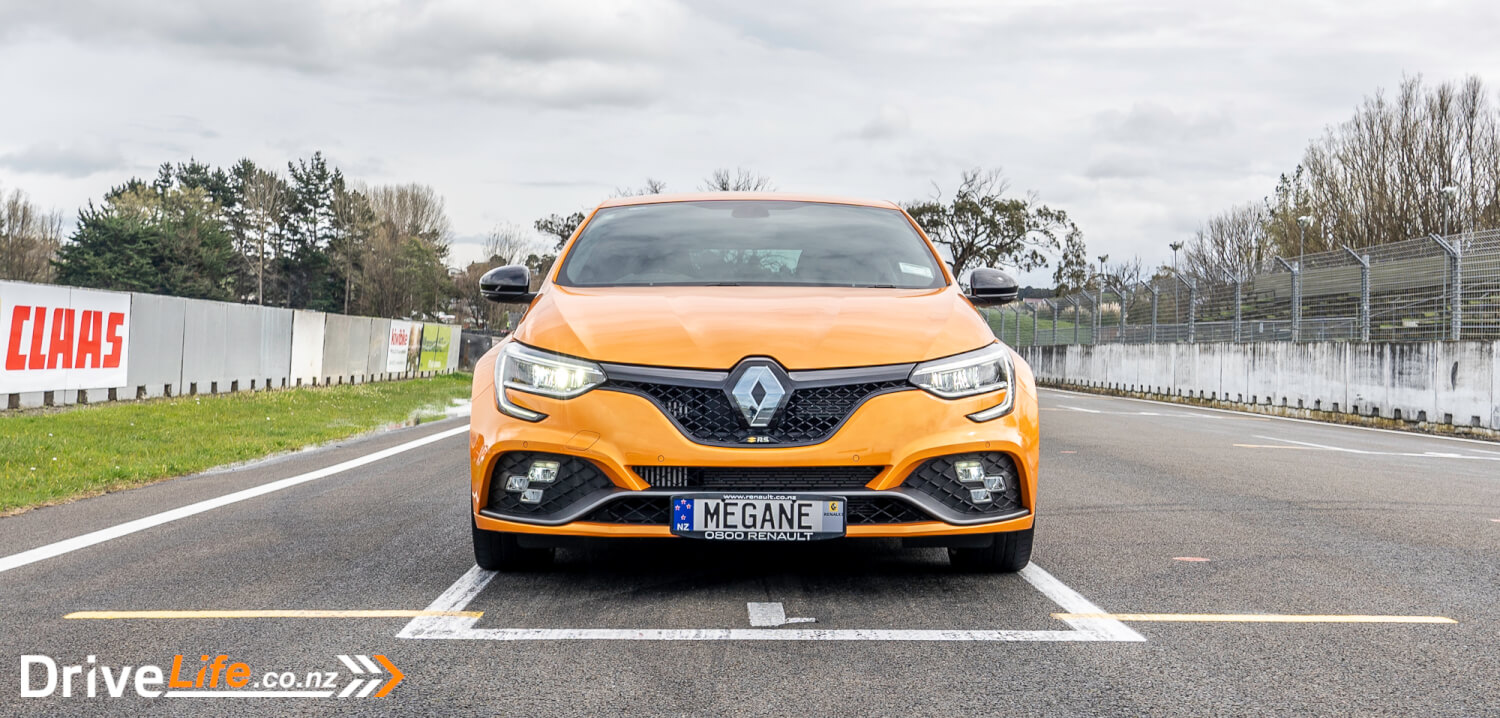
The R.S. is very much the same as those early turbo-performance cars but with far better handling capabilities. It demands respect and it demands a driver who can handle a car as raw as the R.S. This is not a car for someone overconfident in their abilities, or a younger, less-experienced driver. While it’s not a rocket ship – 0-100km/h takes 5.7 seconds – the overall performance is stunning. Midrange passing is a blur, and the engine doesn’t stop giving its all until the 6,500rpm redline. An example of required respect was when I overtook a truck and floored the gas pedal. The car shot forward as I changed lanes to pass, but I had to hang on to that awesome sports steering wheel, as I felt the front wheels trying to lurch left and right.
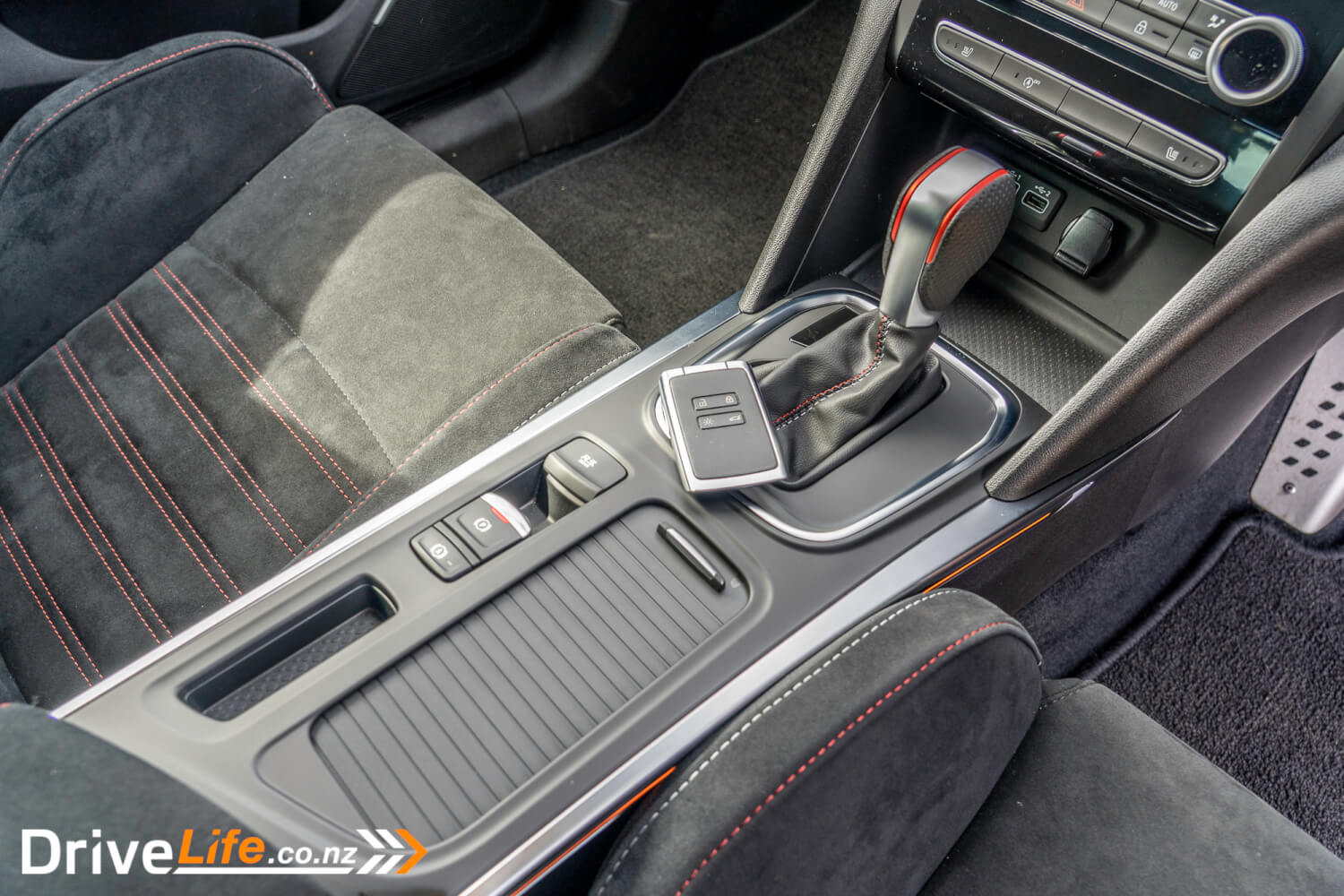
It does have a Torsen limited-slip differential, and that’s essential. Grip on hard acceleration is surprising; Yes, there will be axle tramp, but the car gets the power down. The proof of this is when you switch to Race mode with no ESC and then there’s hell to pay. While it may feel raw to drive, electronics assist this car to get its power onto the tarmac.
From the driver’s seat, there are some nice, clear gauges. It’s an active dash, so you can change the style of the dash to suit your drive mode. Sport mode sees a big rev counter dead centre, while Race mode changes the rev counter into a bar-type unit, which is not good at all, being too hard to read in a hurry. You can customise the dash to whatever you want in each drive mode, so that means you can change that race mode dash to something more readable.
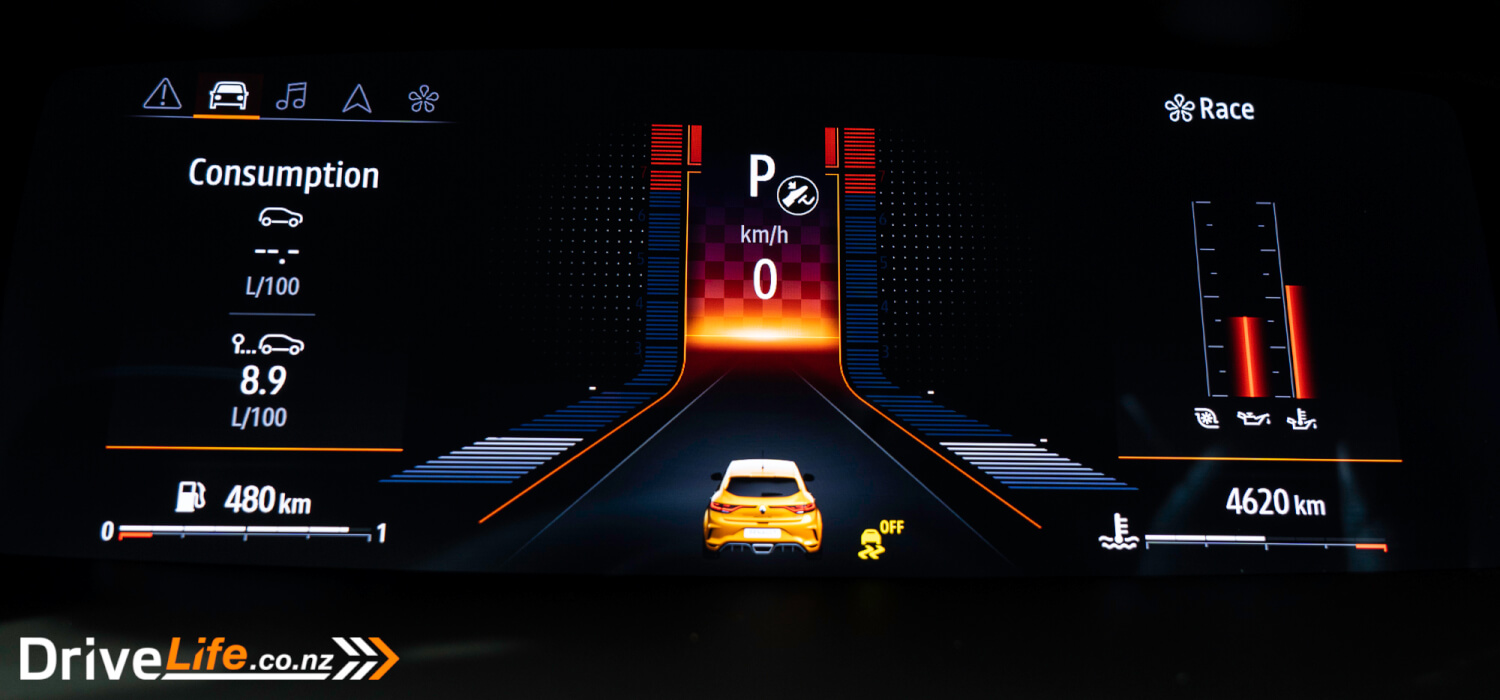
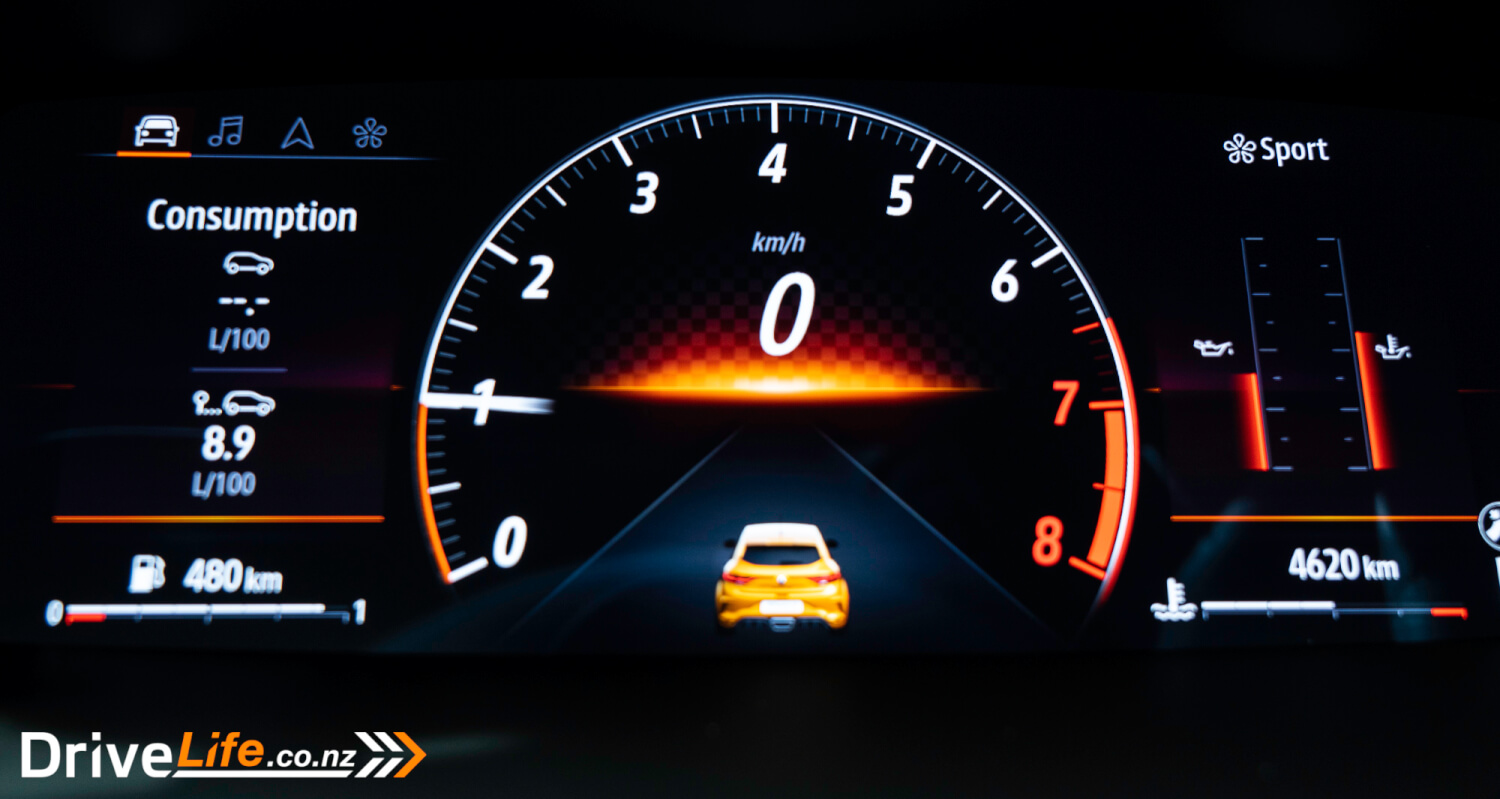
Around the outside of that slightly flat-bottomed steering wheel are the paddle shifters. They are huge, rising up into the air so there should be no chance of missing them on a spirited drive, or on the track. But they don’t move with the steering wheel, which is a real shame. I often found myself reaching for them mid-bend, only to find they weren’t there.
The centre display is nice and clear too, and a good size as well. The resolution is excellent, although it can lag a little between screens. Below the screen are the seat heater buttons; they have just the two settings, compared to three of most cars. The two settings either are – or should be named – ‘Thermonuclear’ for the hottest setting, and ‘Boil your ass’ for the lower setting. These things can cook a chicken on a long trip.
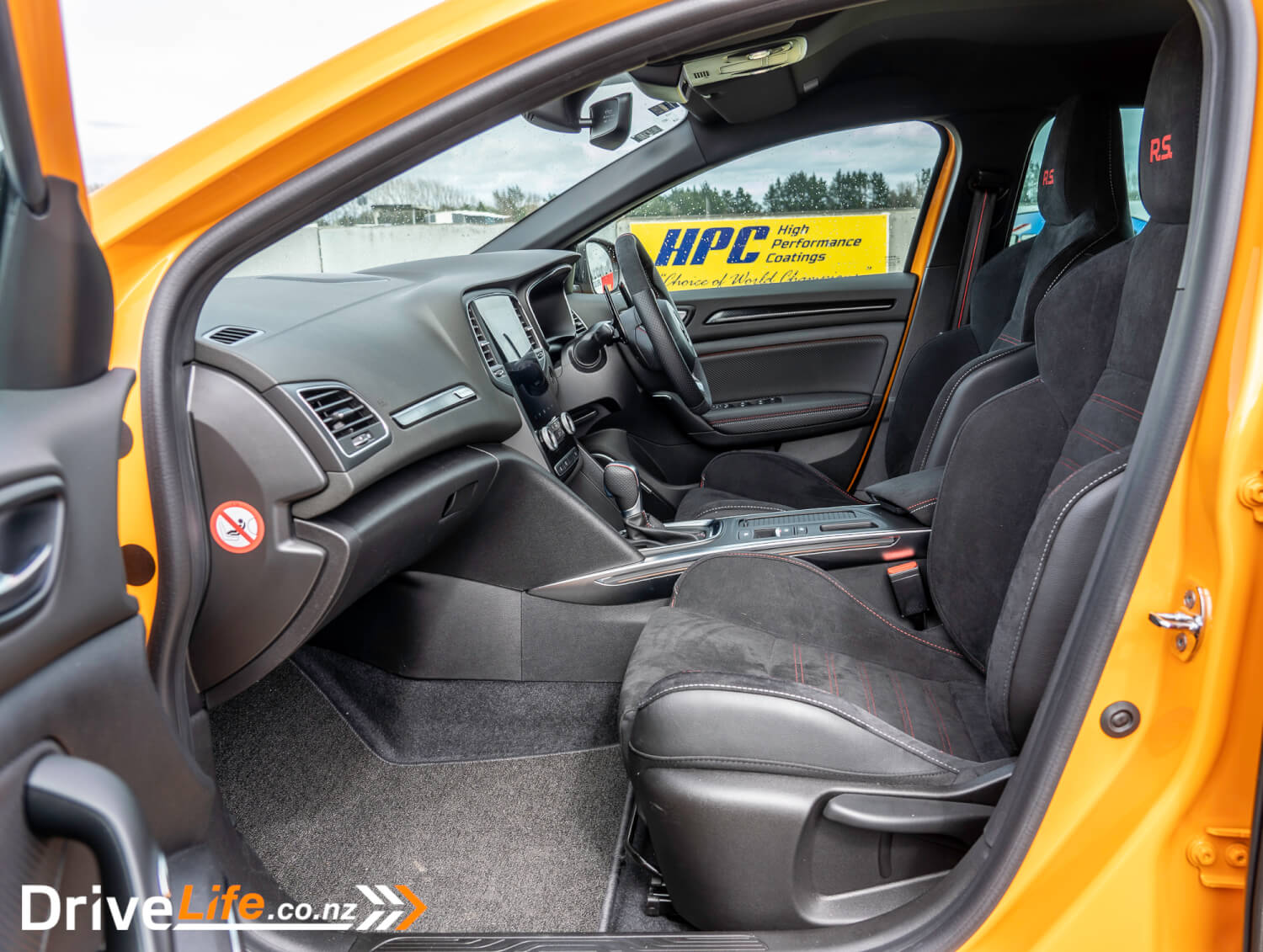
Speaking of long trips, on my last day with the R.S. I decided to head to Manfeild racetrack to take my photos. This would also give me a chance to take the car on a reasonably long trip, including boring Highway 1 on the way to Feilding, and then across the Paihiatua Track and back home via Highway 2, Masterton and the Remutaka Hill.
Leaving Wellington in light traffic, the drive north was a breeze. It gave me time to reflect on what the Megane R.S. doesn’t have for its $68K price tag. You only get standard cruise – not adaptive, there’s no blind-spot monitoring, no wireless phone charging, no electric seats, no lumbar adjust.

But I didn’t care. The more I came to realise the R.S. is a race car for the road, having luxuries like adaptive cruise control seem like performance-zapping extravagance.
There is a Bose sound system, but for me the audio quality was only average, and weirdly when changing drive modes, the audio would switch into some sort of surround sound. I have no idea what that was about. There’s no volume knob, and the car has an audio stalk instead of steering wheel controls. Although I’m not normally a fan of the audio stalk in any car, after my time with the car the stalk worked just fine.
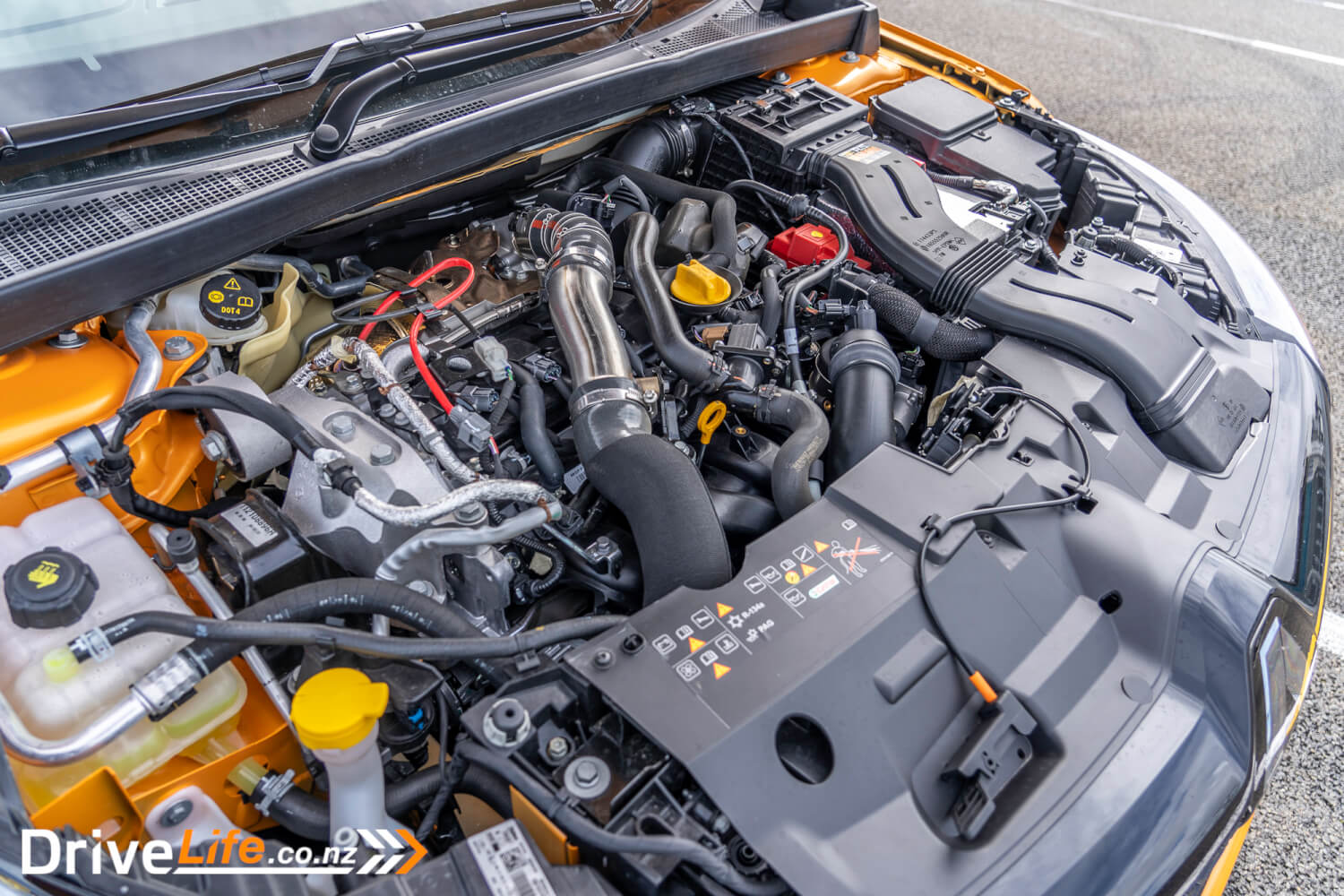
At times, I ran the car in Save (eco) mode to see how it went. This wasn’t an issue; with a reasonably lightweight at 1,450Kg and 420Nm of torque peaking at a low 2,4000rpm, Save mode was too easy. When in Save mode, you get a green leaf on the dash that grows bigger and bigger, like an automotive version of Pinocchio. I will admit to making the tree grow large on the drive to Feilding as the R.S. and I simply cruised along.
I was concerned about how comfortable the seats might be on a long trip; They look and feel firm and unforgiving. But to my surprise, on my whole 400Km day of driving, no aches or pains or anything else. They were excellent.

Rear visibility is not great, with big headrests and a narrow rear window. For some reason, this reminded me of the movie Gumball Rally, where Franco says, “What’s-a behind me is not important”, and then breaks the mirror off and throws it away. That’s what the R.S. can do to your mentality.
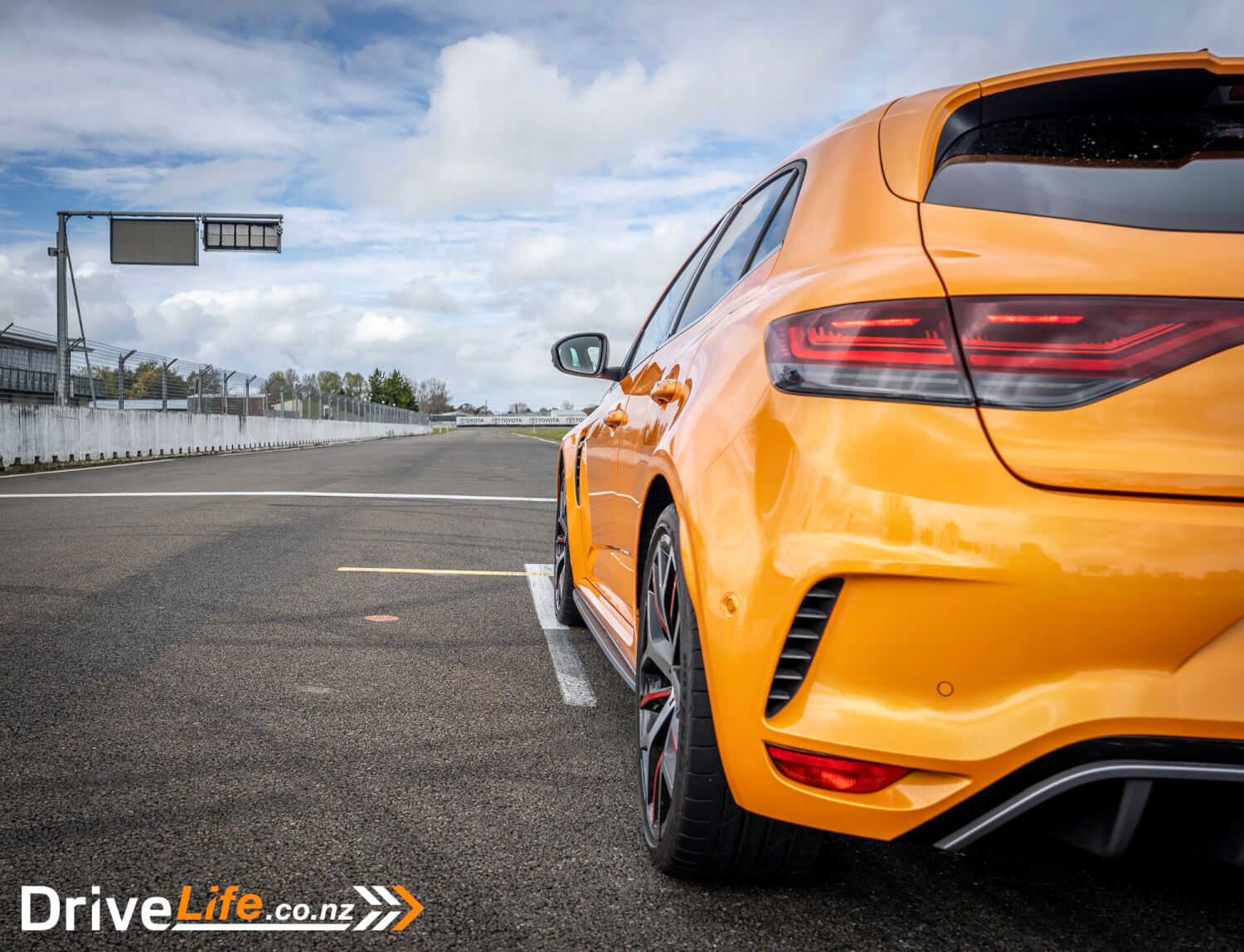
After 2.5 hours, I arrived at Manfeild racetrack, and they graciously allowed me to drive around the track to find a spot to take photos. I wasn’t allowed to ‘race’ around the track but stopping on the back straight on the way to my photo spot means that I could test out launch control. The R.S. isn’t as easy as say an Audi to get into Launch Control. The process is to select either Sport or Race mode, hold both paddles until ‘Launch Control Active’ appears in orange on the dash. Then foot on the brake until ‘Launch Control’ goes green with ‘Launch Control Active’, then off with the paddles, down with the gas pedal, and when you are ready, release the brake. In Sport mode (with ESC on) it shot forward very nicely, the power being sent down to that smooth tarmac. I tried again in Race mode, and this was a different story. Lots of wheelspin – but reigned in early on – and much forward momentum. While it’s not the fastest kid on the block to 100km/h the way it does it in Launch Control makes it a lot of fun.
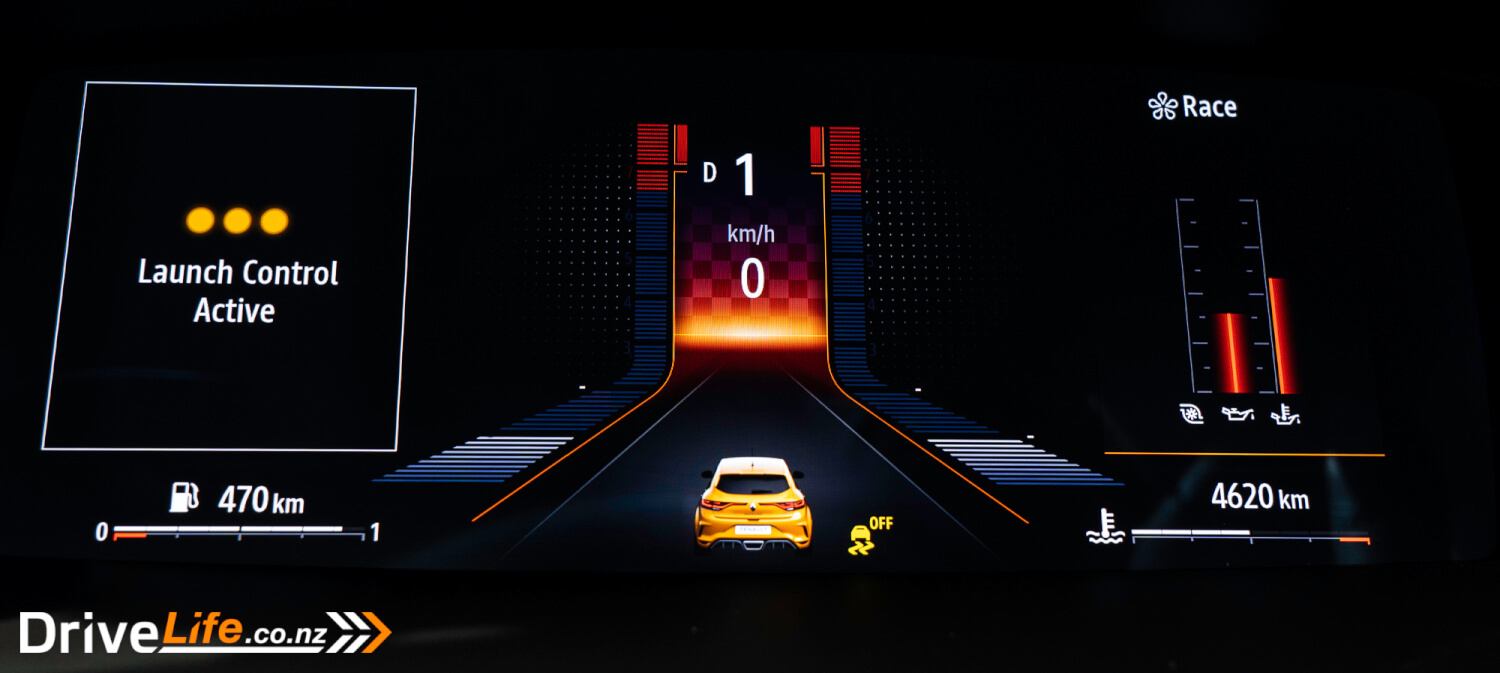
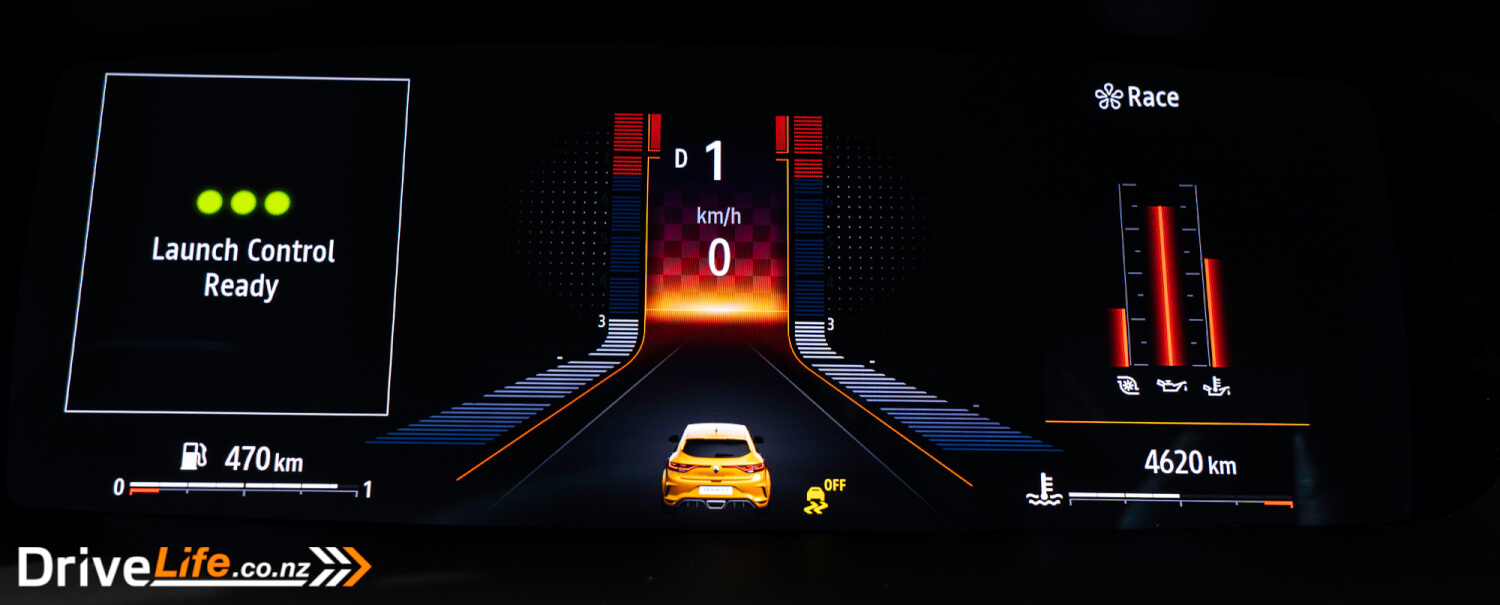
Race mode will also deactivate Emergency braking, Lane Keep Assist, and the speed limiter. Definitely a mode for the track.
Continuing on around the track, this car sits flat. I thought the Honda Civic Type R was the king of flat cornering in a front-wheel drive, but I think there’s a new king. The Megane R.S. carves through corners like – and I hate to say this over-used statement – like it’s on rails. Part of that – and I really noticed this on the track – is likely down to the 4Control, or 4-wheel steering. You can actually feel it working as you get the car quickly around the bends, racetrack or road. This also aids the turn-in, and the turn-in on the R.S. is excellent.
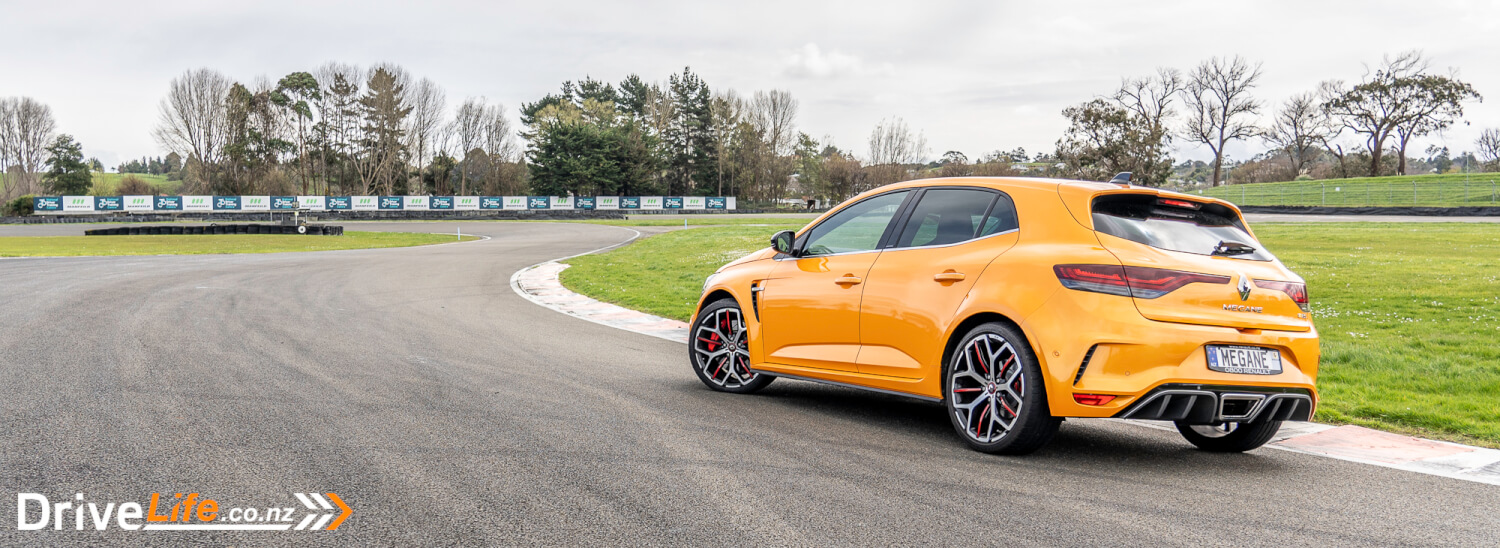
I had concerns that the hard-riding side of this car would mean some skipping on bumpy corners, but the rebound damping on the R.S. is superb. Even mid-corner bumps would not unsettle the car in the slightest. Grip on corners is also excellent, with those Bridgestone Potenza tyres at 245/35/19 holding on to the last. For a front-wheel-drive car, the R.S. is outstanding in the handling department.
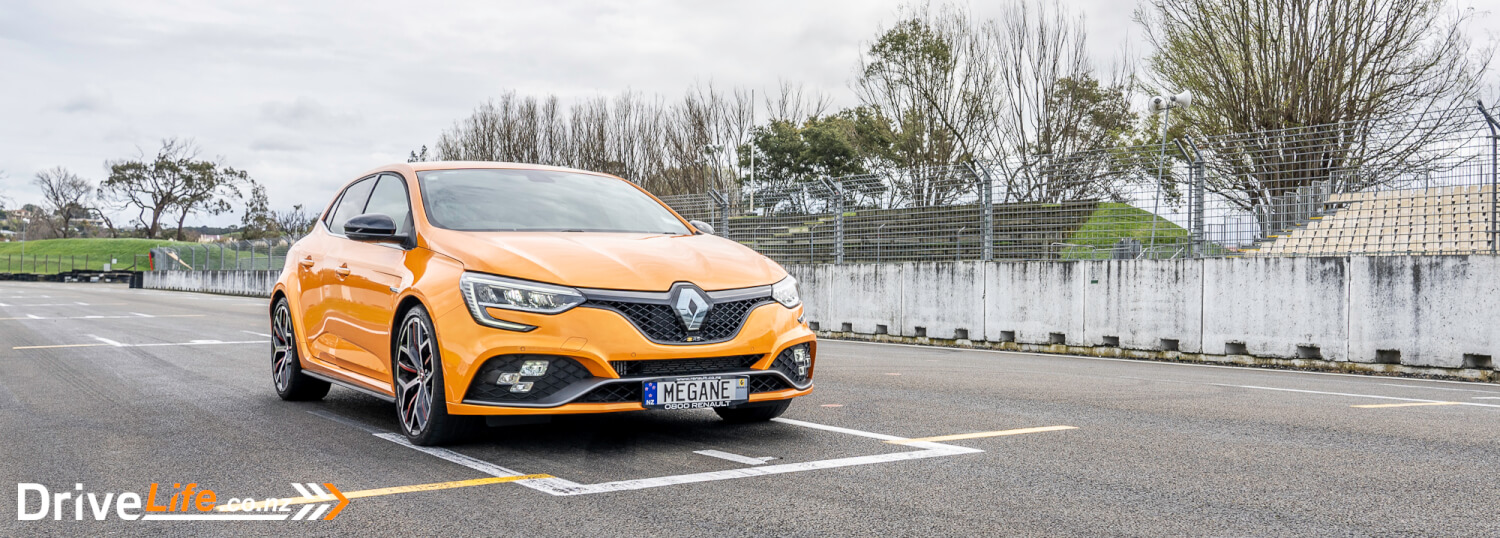
As expected, there’s rev-matching in Sport or Race mode, and the exhaust sounds are both stupendous and childish. Aside from the handling, the noises that this car makes also trumps the Type R by a very long way. I expect there’s going to be a few Honda Civic Type R owners with their windows down, listening as a Megane R.S. drives past. They will be jealous, especially since this is a real weakness of the Type R. The engine in this Renault is easily as smooth as the Type R or i30N as well; right out to the redline, it sounds great and is extremely smooth at any revs. For that reason, I was disappointed that the car doesn’t come with a heads-up display (HUD). With the engine so smooth and spinning so quickly to the redline, a HUD allows the driver to make the most out of gear changes, nailing them right on the redline without having to look down. Hopefully, the next update will see a HUD as standard.
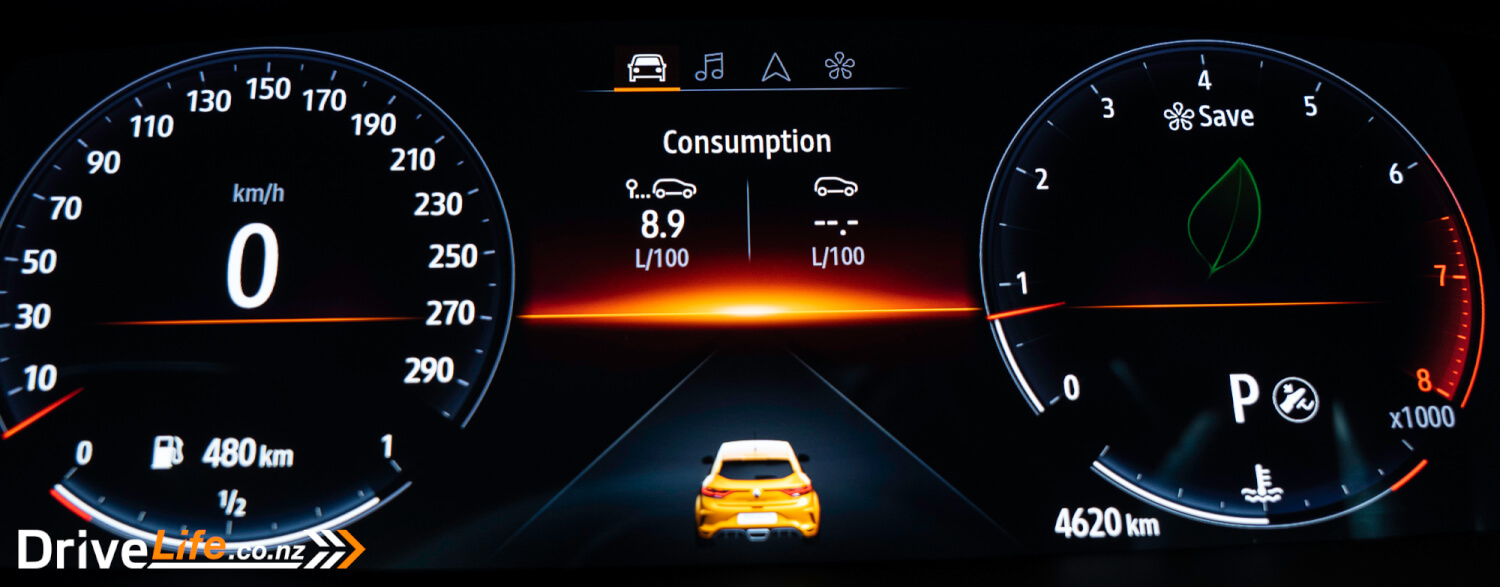
I haven’t mentioned it yet at all, but it’s time; the steering feel on this car is the best I’ve had for a very long time. You feel every bump on the road (or track) through that wheel, and that makes it so much easier to drive it on the limit, knowing exactly what’s happening up front below the tyres. Yes, it makes for heavier steering at all speeds, but the payoff is worth it. The steering is very quick too, as you’d expect. It absolutely nails the whole “I’m a real race car” feeling.
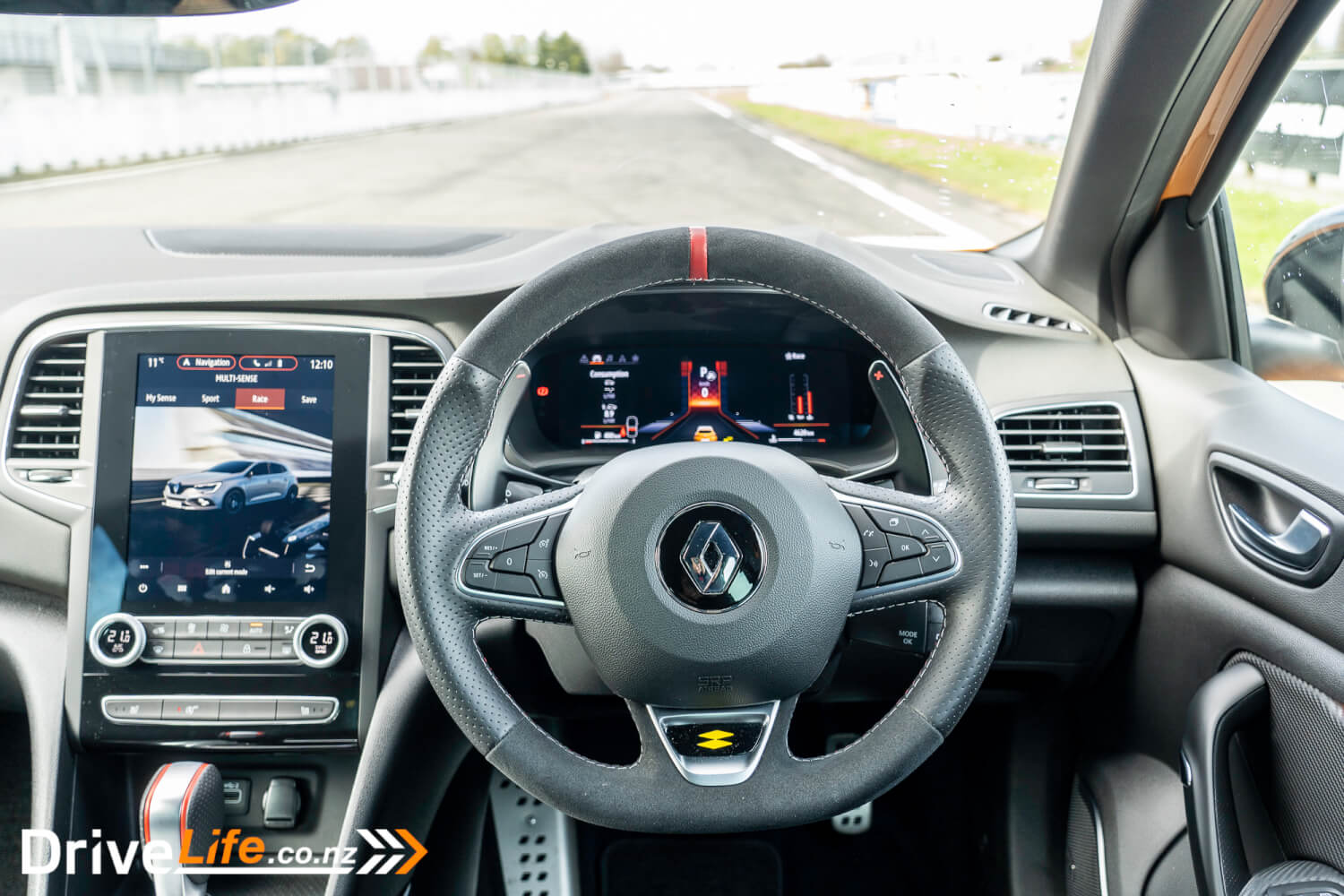
On the track, I used the paddles for manual gear changes. As mentioned, this isn’t ideal since they are fixed. So I thought I’d use the gear lever instead, but it’s definitely set for a Euro car; to move the car into manual mode for the gearbox, you have to shift the lever to the left, which means it’s further away from you. Back to the paddles it was. The gearbox on the whole is excellent. Being a dual-clutch, you still get that slowness away at low speeds, while the clutches disengage. But on the move, it’s a dream, with lightning-quick changes in Sport and Race modes. Of course, each change up is met with a bang from the exhaust if you are using full throttle. Race car much? I loved this aspect of the car, and it was one of the reasons I wasn’t so concerned it wasn’t a manual.
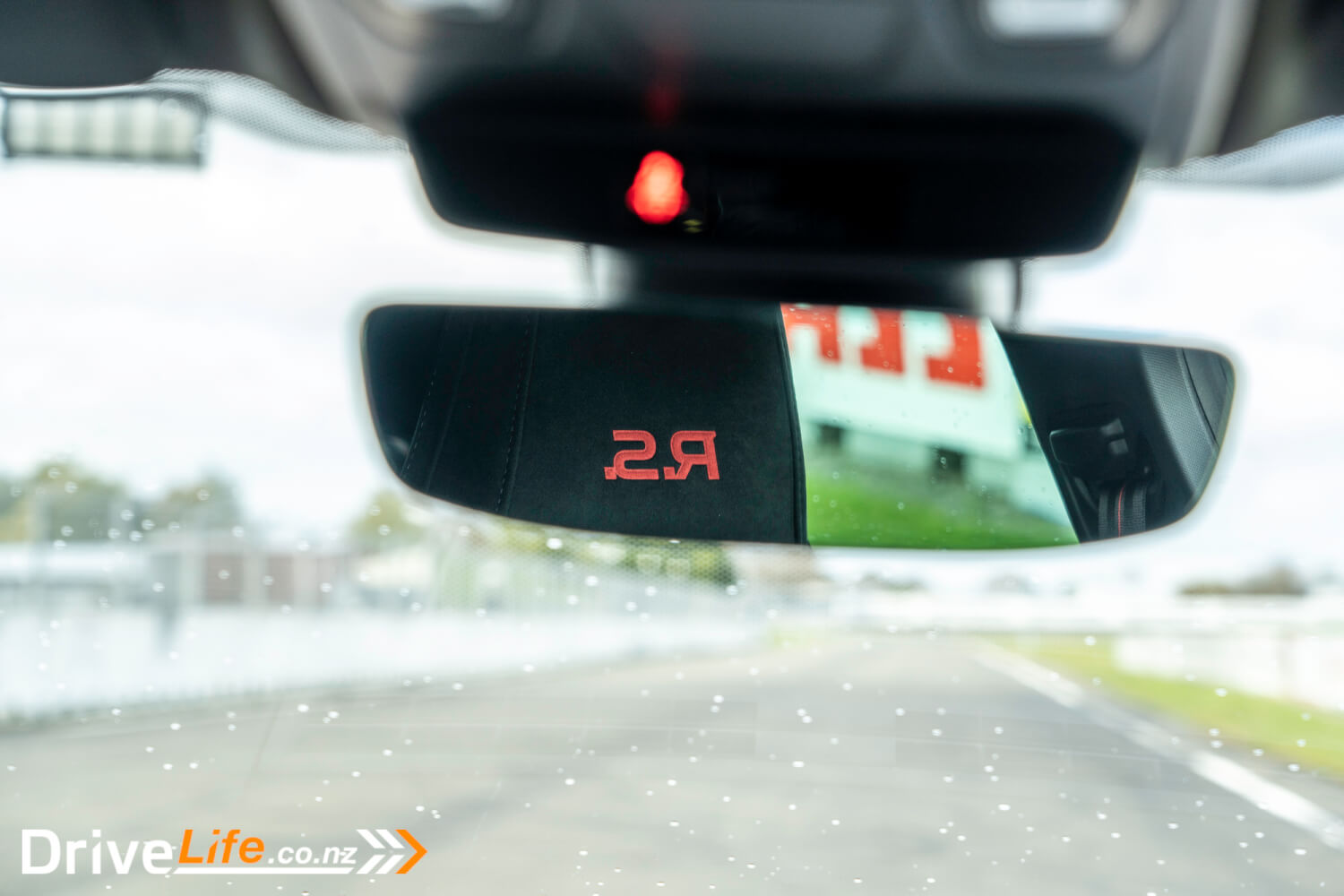
The brakes are quite large, at 355mm discs for the front and 290mm for the rear and red Brembo brake callipers front and rear. The braking power is there but for me, the pedal was a bit too soft, and lacking in feeling. This was the one area where I felt the Megane had not nailed the whole race-car effect. I see other owners and motoring journalists not mentioning the same thing, so perhaps it was just our test car.
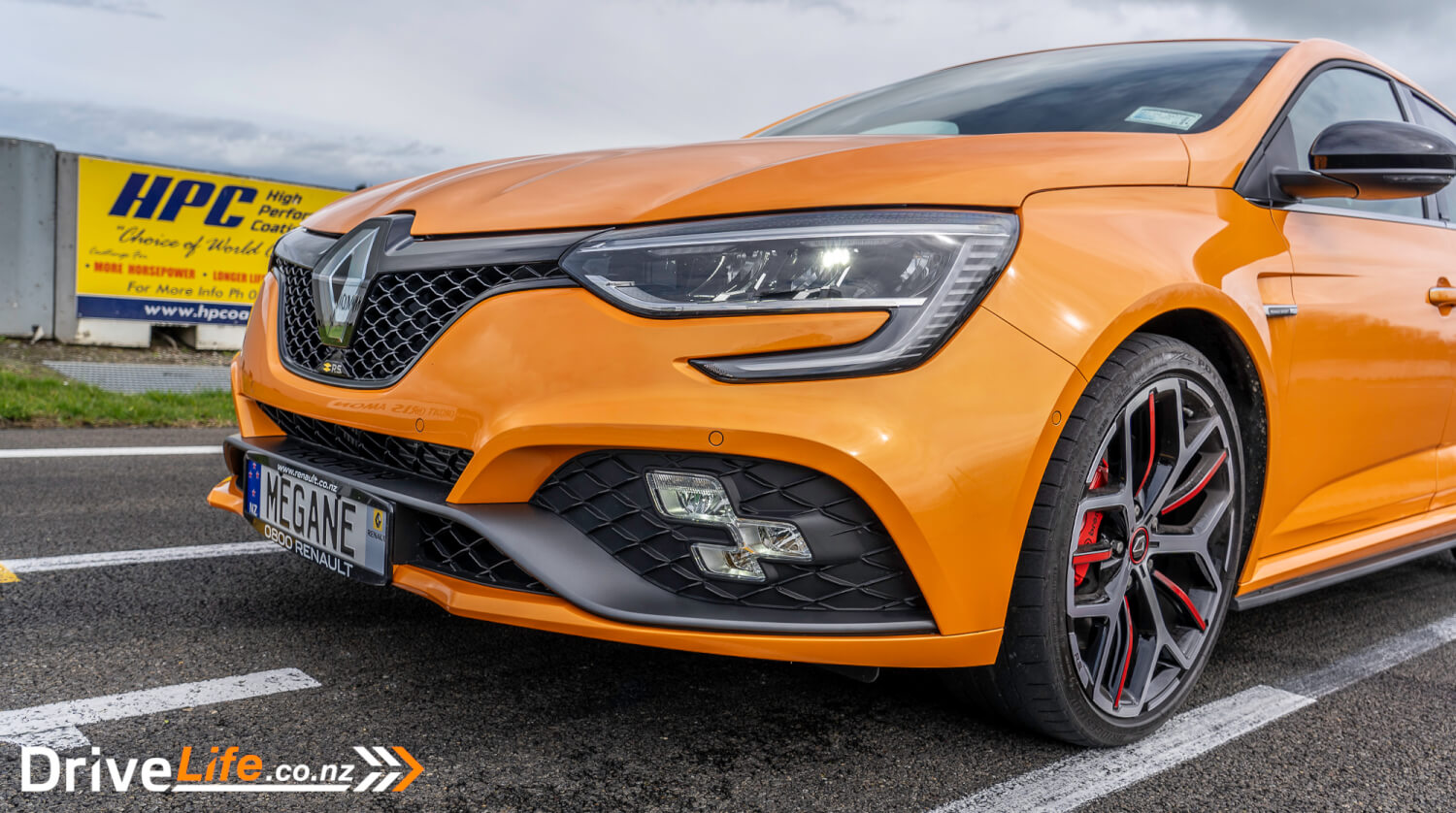
After Manfeild it was time to head over the Paihiatua Track to SH2 and home. Since the Manawatu Gorge is still shut, there was a fair amount of traffic on the track, but I managed to get a few bursts of no traffic at all. It just compounded what I had already learnt about the handing, steering, performance and sounds of this car. Such fun. I also managed to get a full run up the Masterton side of the Remutaka Hill, and this gave the same result; The Renault Megane R.S. loves to corner.
Renaults suggests that the car should use around 8.0 litres of premium (only) fuel for every 100Km driven. After driving 900 kilometres in this car, my result was 9.0. Higher? Sure, but still very impressive when you consider the performance of this car.
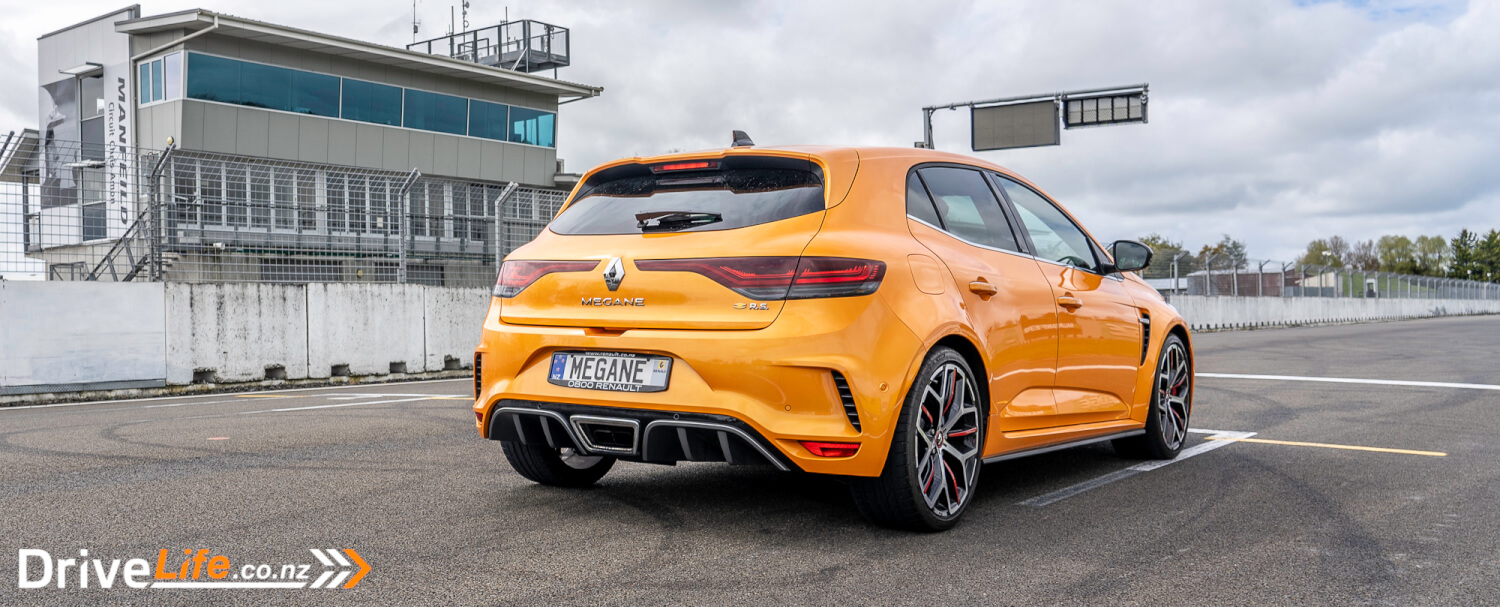
Thanks to Manfeild for allowing us to take photos of the Megane R.S. 300 Trophy on their track.
HOW DOES THE 2021 RENAULT MEGANE R.S. COMPARE TO ITS COMPETITION?
| Brand/Model | Engine | Power/ Torque kW/Nm | 0-100 | Seats | Cargo capacity, litres | Fuel L/100km | Base Price |
| Volkswagen Golf R Performance (AWD automatic) | 2.0-litre, 4-cylinder, turbo petrol | 228/400 | 4.6 | 5 | 343 | 7.2 | $76,990 |
| Renault Megane R.S. Trophy 300 (FWD automatic) | 1.8-litre, 4-cylinder, turbo petrol | 221/420 | 5.7 | 5 | 434 | 8.0 | $68,990 |
| Honda Civic Type R (FWD manual) | 2.0-litre, 4-cylinder turbocharged petrol | 228/400 | 5.7 | 4 | 420 | 8.8 | $62,990 |
| Subaru WRX STI (AWD manual) | 2.5-litre, turbocharged horizontally-opposed Boxer 4-cylinder petrol | 221/407 | 4.9 | 5 | 460 | 10.9 | $59,990 |
| Hyundai i30N Fastback (FWD manual) | 2.0-litre, 4-cylinder turbocharged petrol | 203/353 | 6.1 | 5 | 436 | 8.0 | $59,990 |
| Ford Focus ST (FWD automatic) | 2.3-litre, 4-cylinder turbocharged petrol | 234/420 | 5.7 | 5 | 273 | 8.6 | $59,990 |
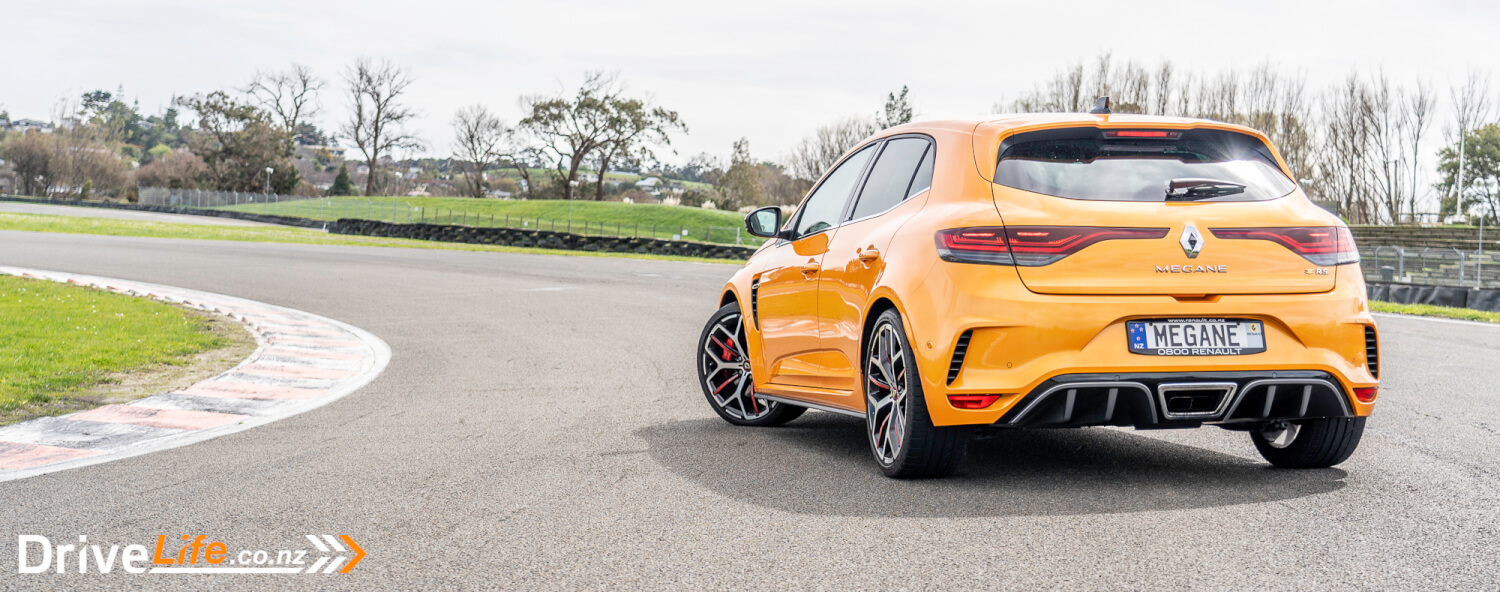
WHAT THE PROS AND CONS OF THE 2021 RENAULT MEGANE R.S.?
| Pros Engine noise Exhaust noise Handling Steering Mid-range acceleration Absolute fun factor Surprising grip for FWD Sits flat through the bends Amazing turn-in | Cons Hard ride (understandably) Paddle shifter mounting No HUD Torque steer & axle tramp Not for rookie drivers Brakes too soft, lack feel |
| Vehicle Type | 5-door hot hatch |
| Starting Price | $68,990 |
| Price as Tested | $68,990 |
| Engine | 1.8-litre, 4-cylinder direct-injection turbocharged petrol |
| Power, Torque kW/Nm | 221@6,000rpm 420@2,400rpm |
| Transmission | 6-speed dual-clutch automatic |
| Spare Wheel | Pump only |
| Kerb Weight, Kg | 1,450 |
| Length x Width x Height, mm | 4356x2058x1428 |
| Cargo Capacity, litres Seats up/seats down | 434/1,247 |
| Fuel capacity, litres | 50 |
| Fuel Efficiency, L/100Km | Advertised Spec – combined – 8.0 Real-World Test – combined – 9.0 Low Usage: 0-6 / Medium Usage 6-12 / High Usage 12+ |
| Turning circle, metres | NA |
| Warranty | 3 years unlimited KM 3 years Roadside Assistance |
| ANCAP Safety Ratings | 5 Star (EuroNCAP rating) |
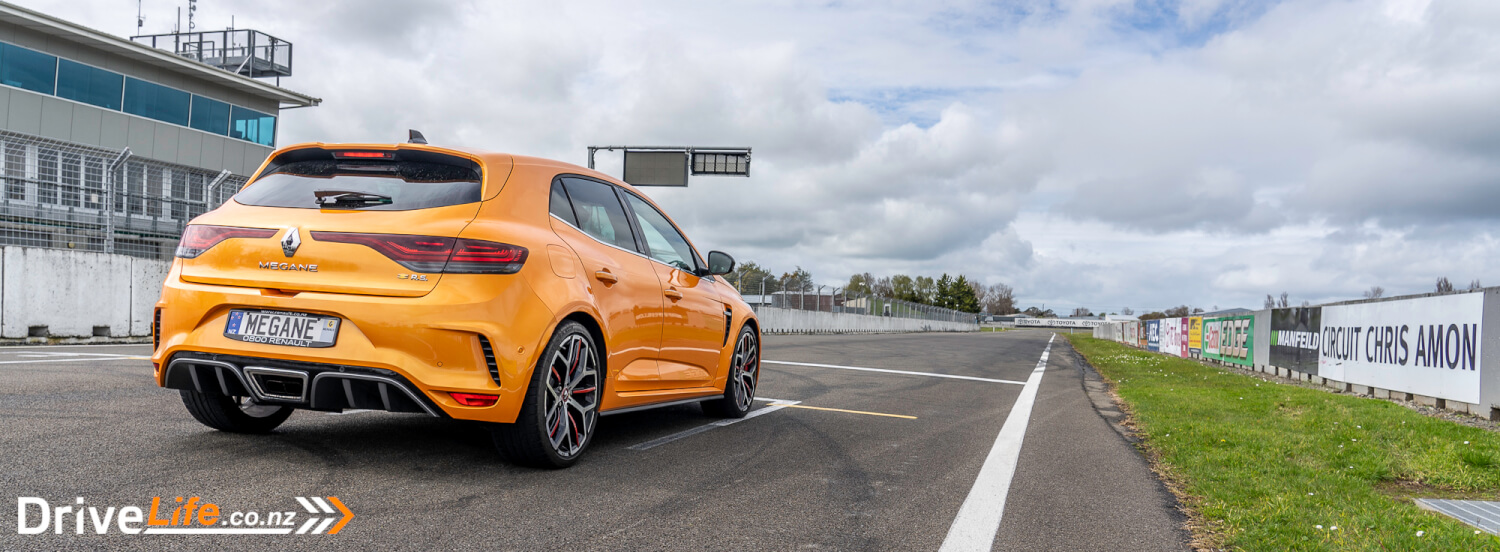


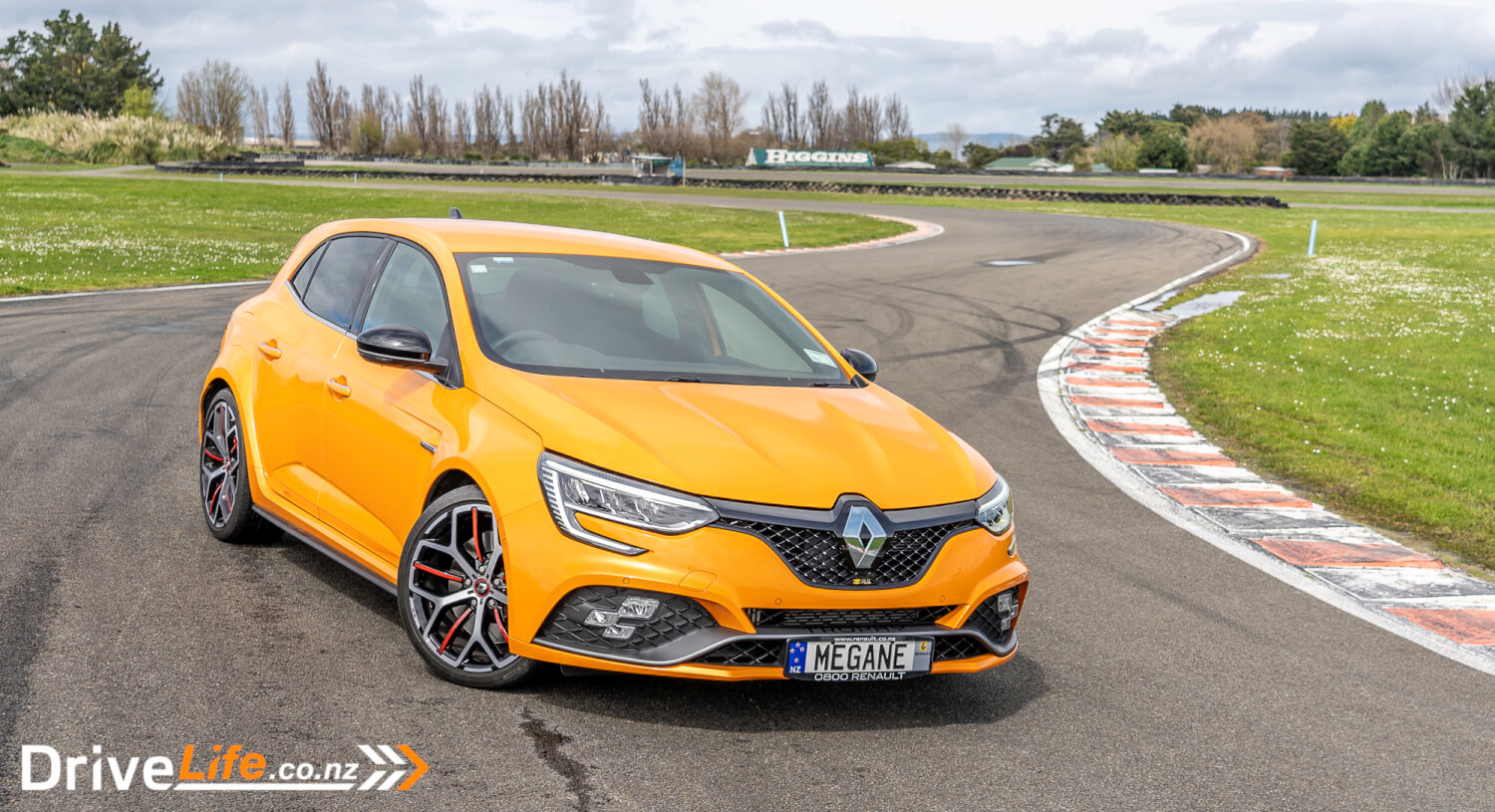
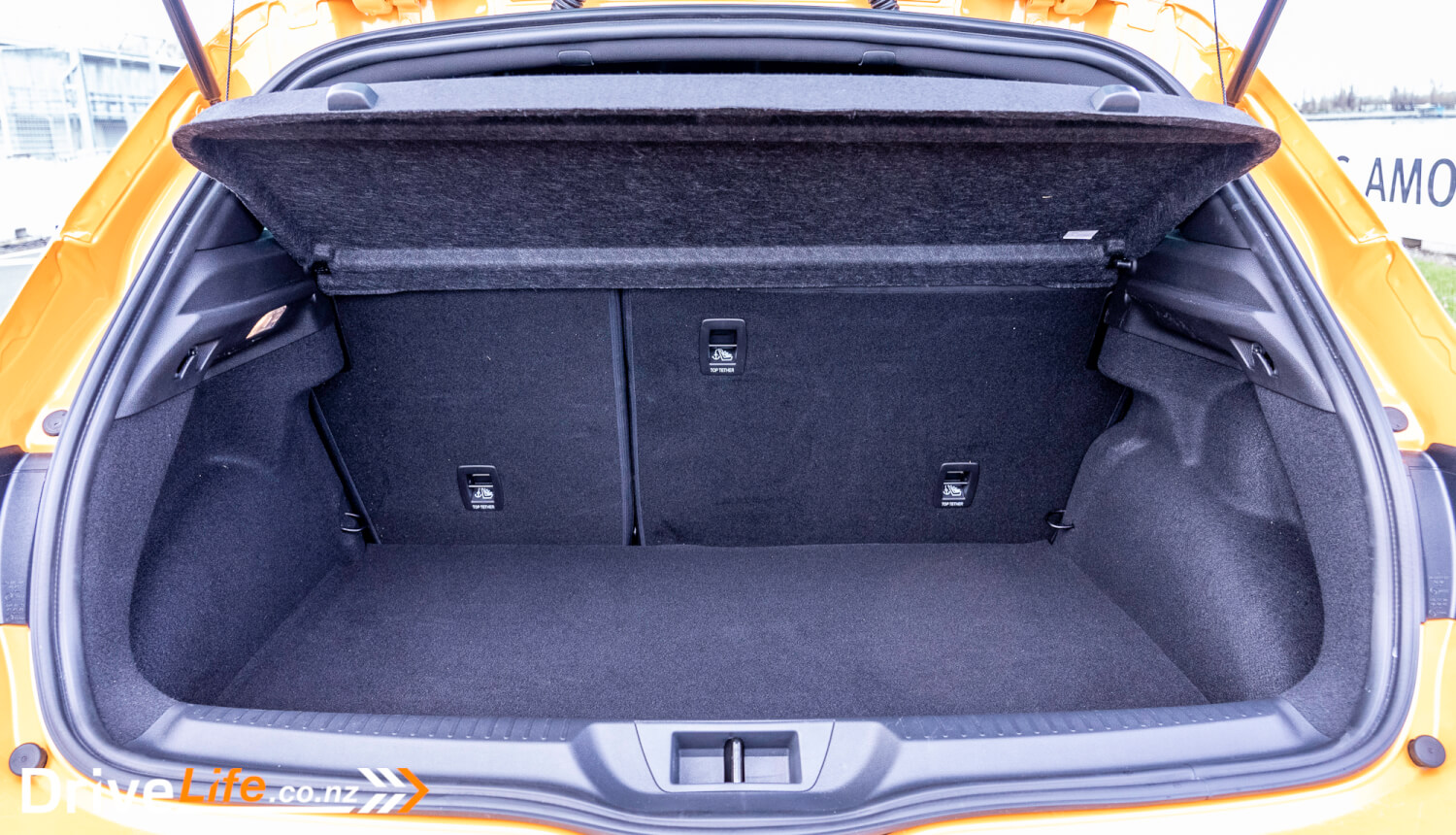
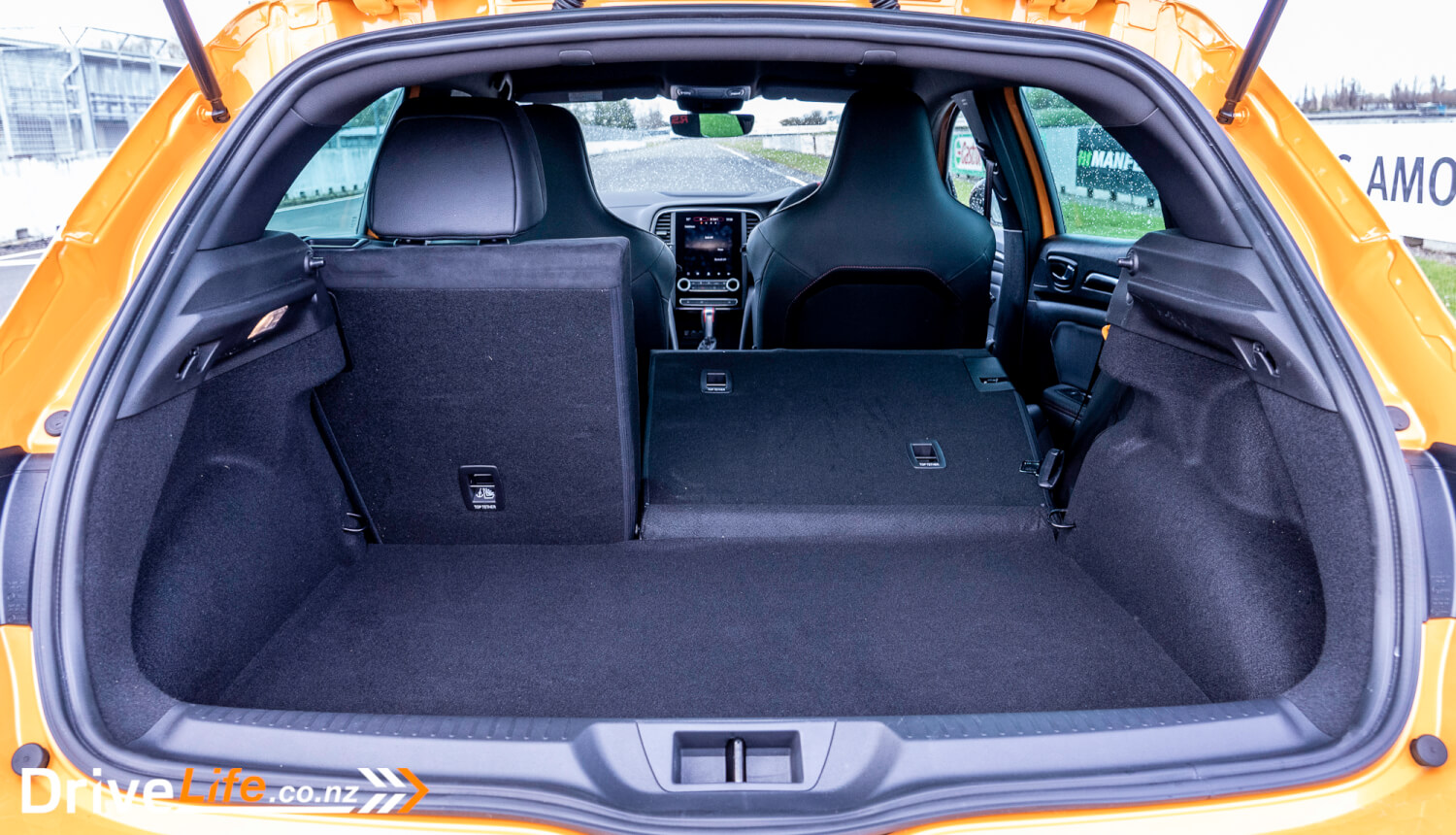
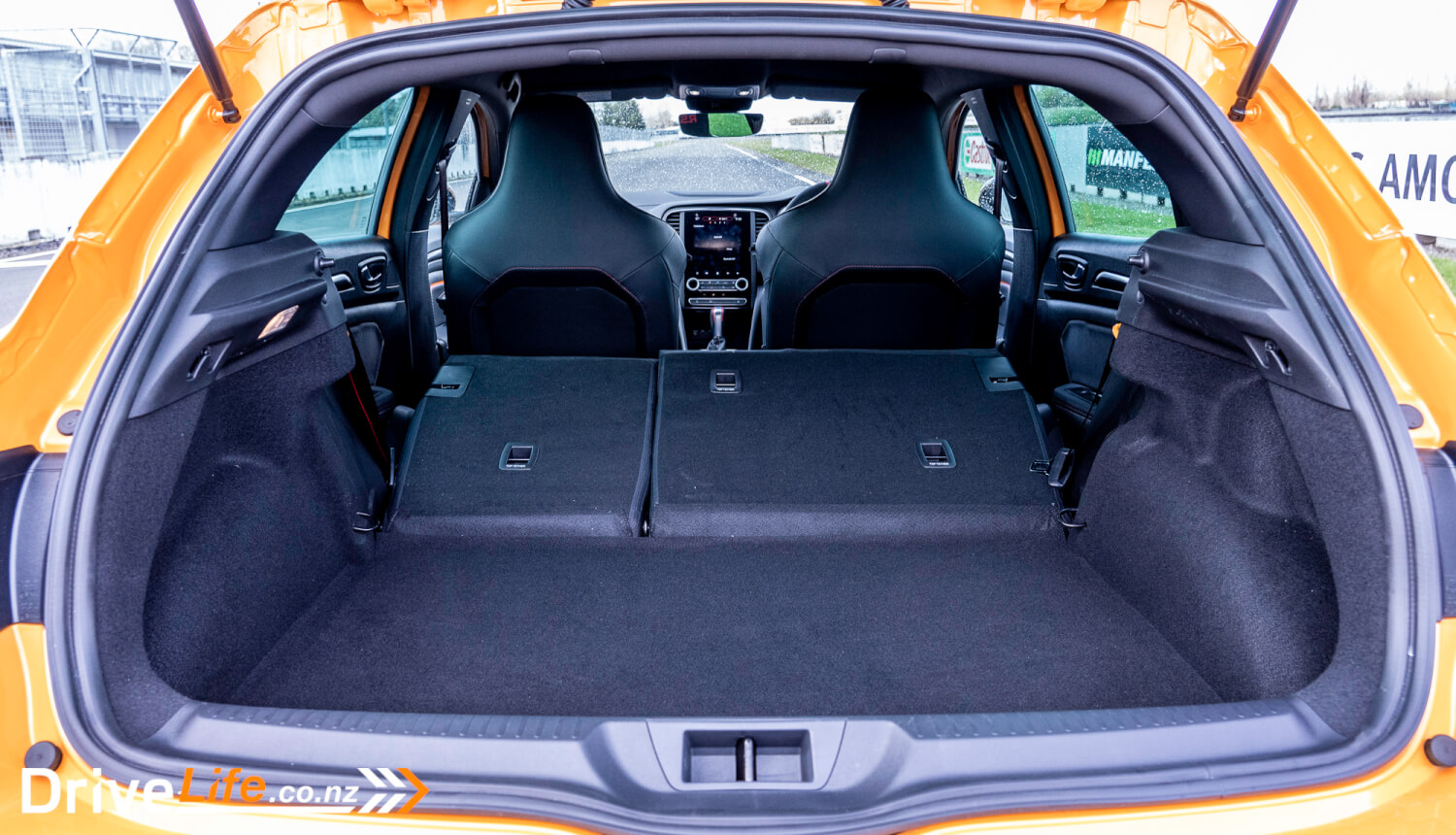
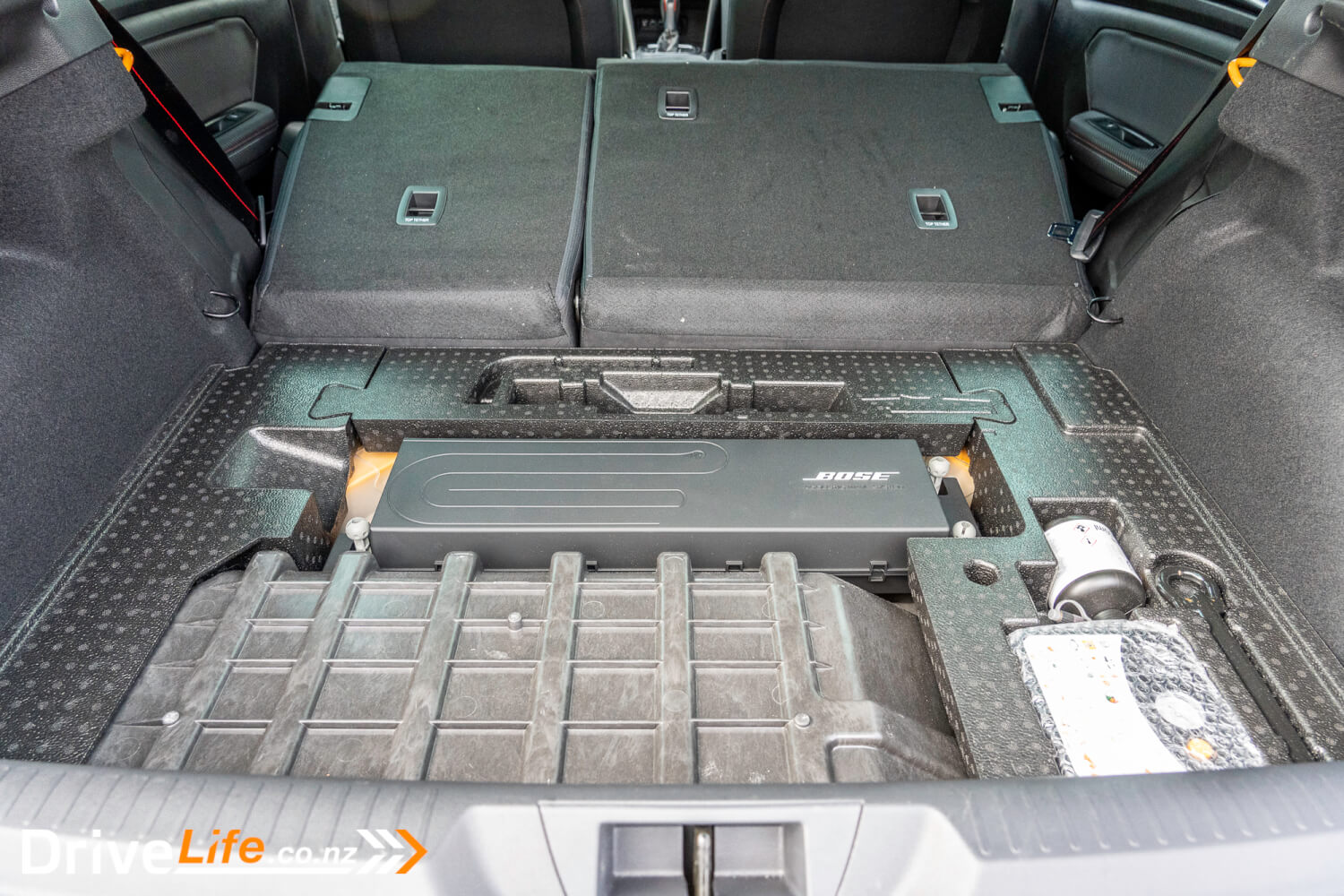











































Nice review. Much more informative than the one that appeared in that print mag 😀
One point – Renault didn’t develop any adaptive dampers for this generation Megane, preferring to use hydraulic bumpstops.
Have you driven the previous Megane RS ?
I’ve done a back to back and found the new car more refined but less incisive, I suspect the rear wheel steer, which the top-of-the line Trophy R omits.
HI Jan
Thanks for the comment. I mention adjustable dampers as I read through the manual for the car, and it shows them as being an option in other countries, just not NZ. Perhaps that’s a mistake in the manual?
No, didn’t get to drive the previous model but jealous that you did a back to back – that’s the ultimate. As mentioned in the review, I found the rear-wheel steering excellent, and it’s one of the few cars with RWS I’ve driven where I could actually feel it working.
Cheers!
Fred